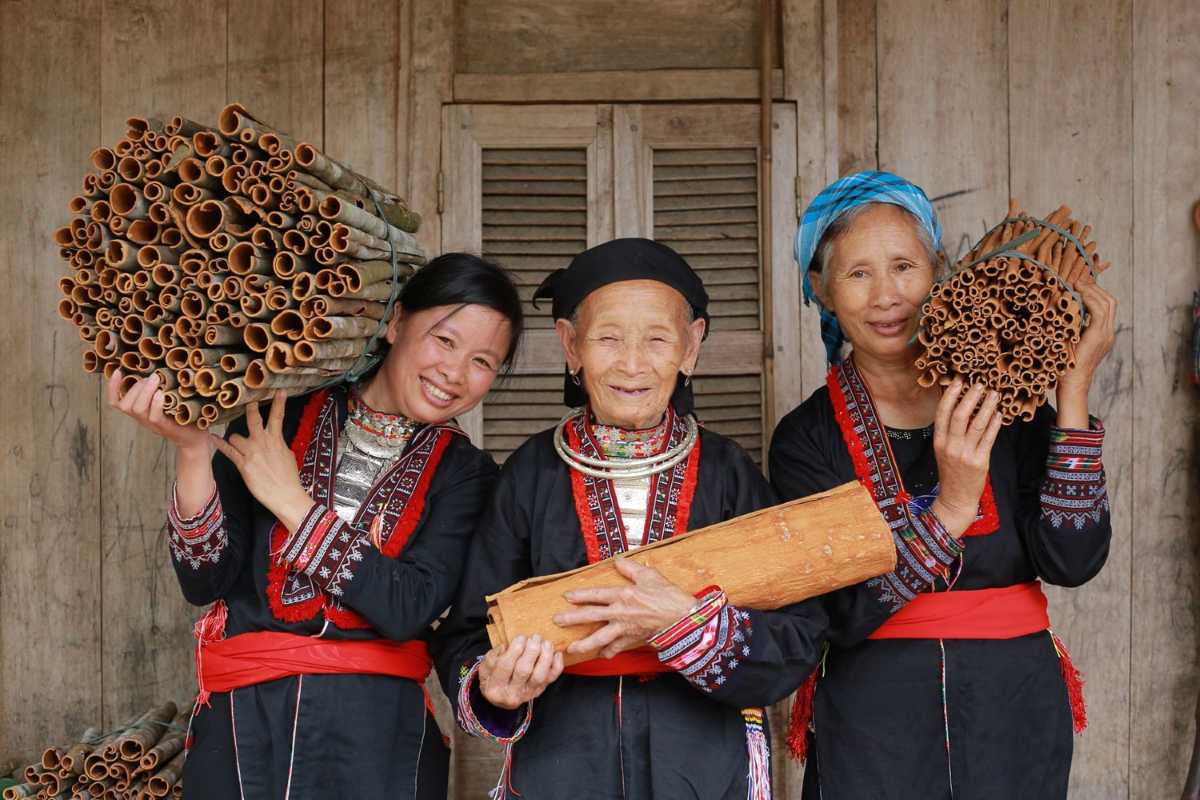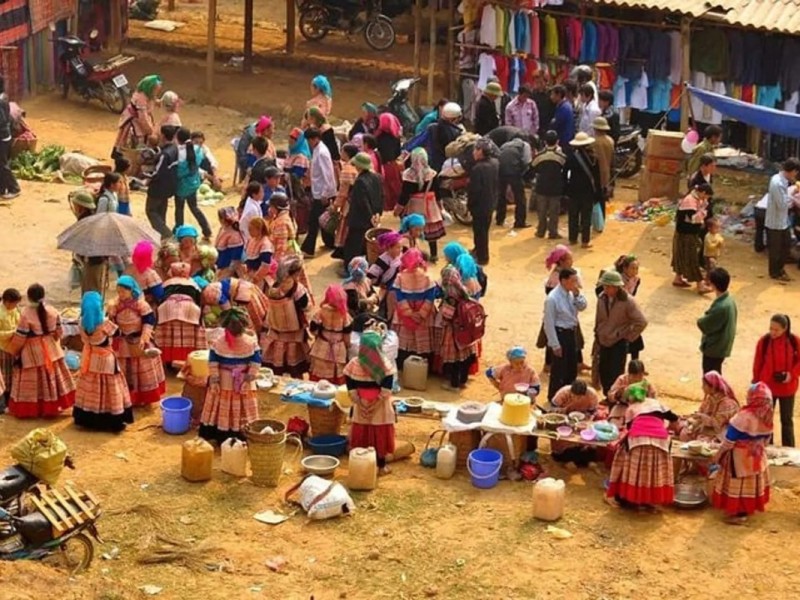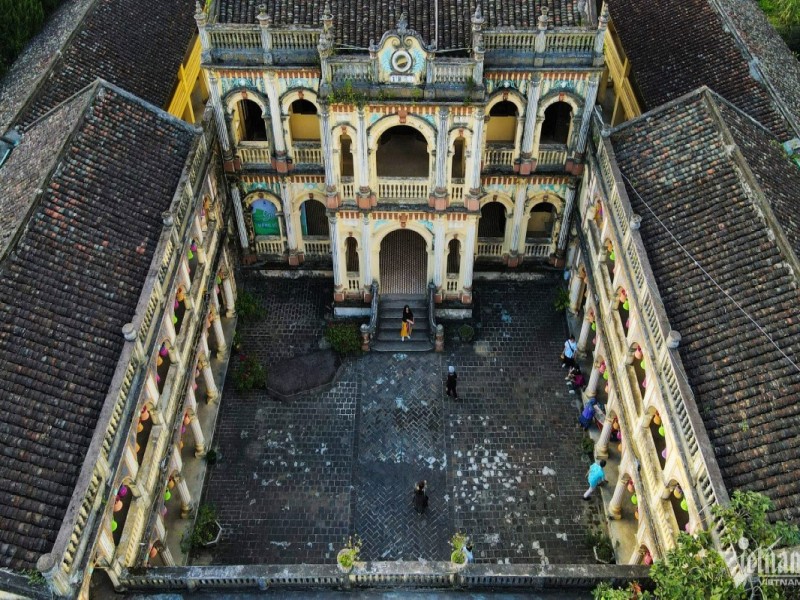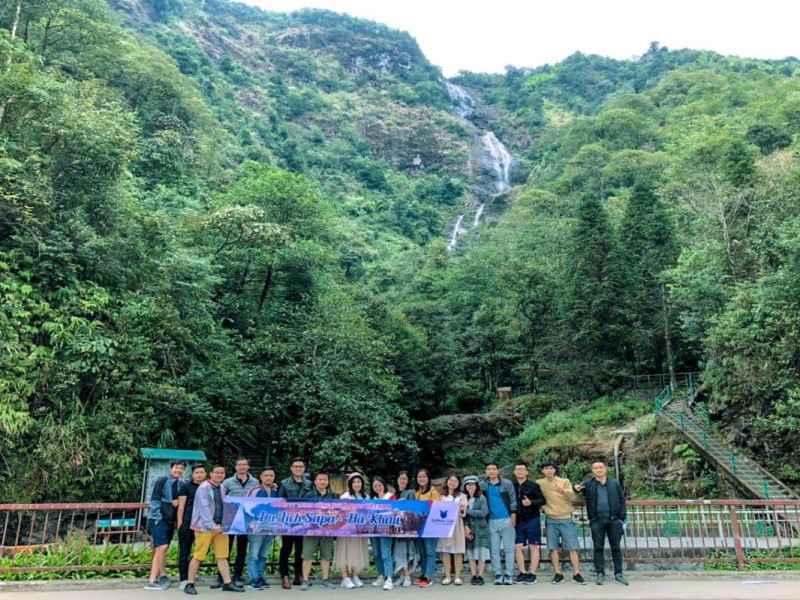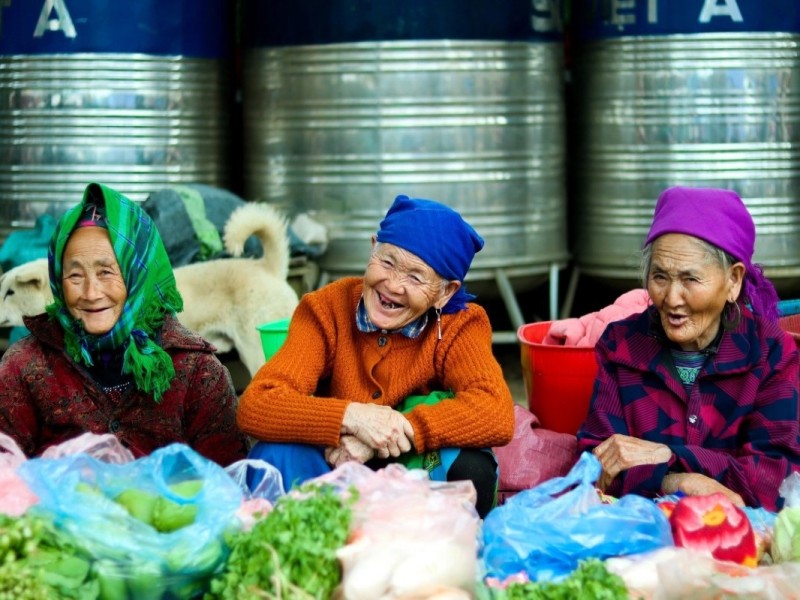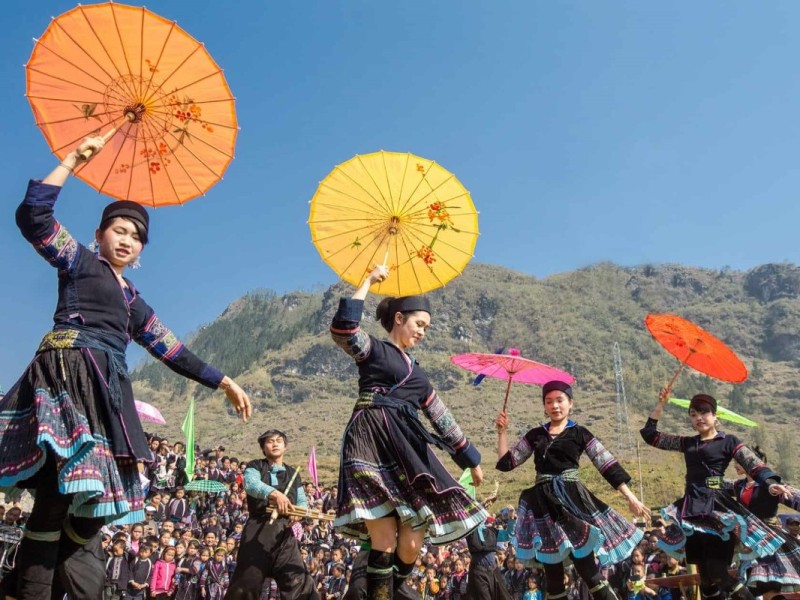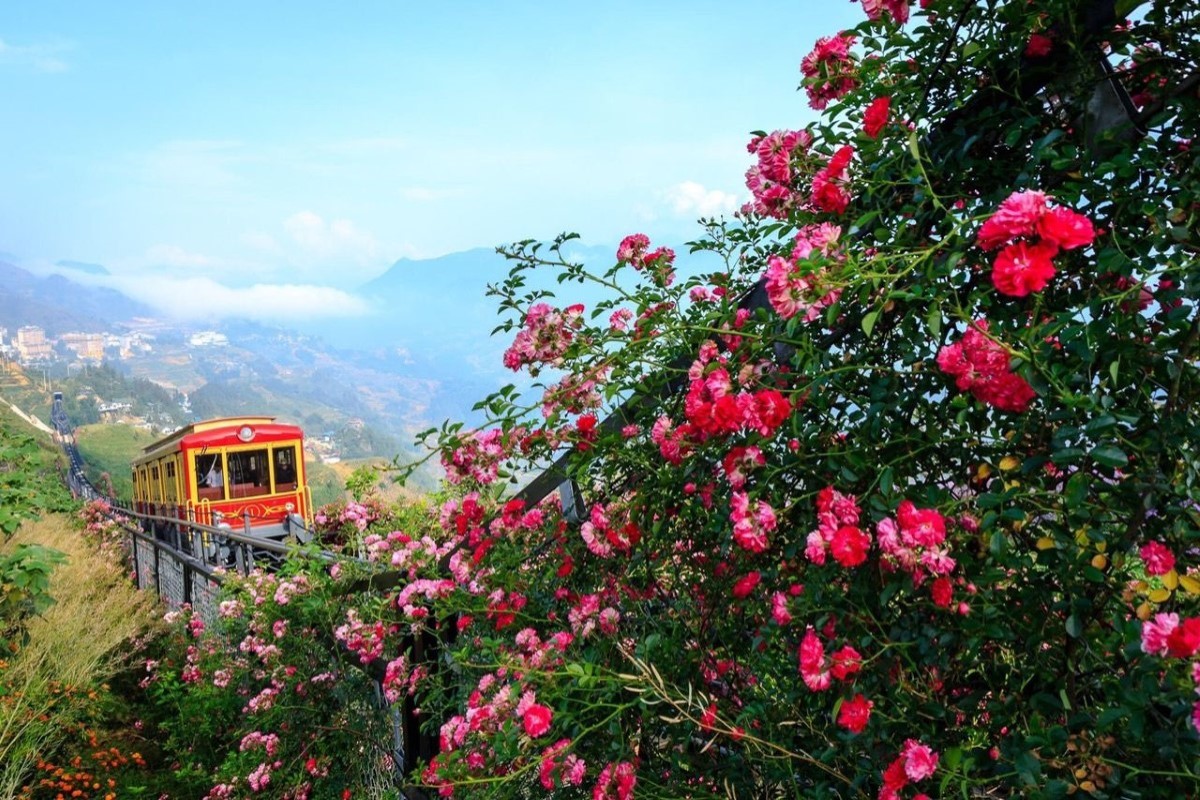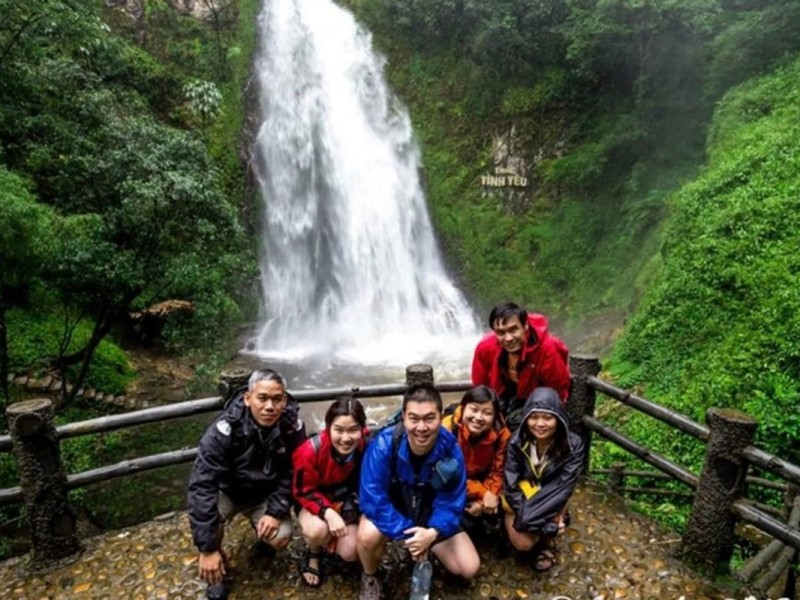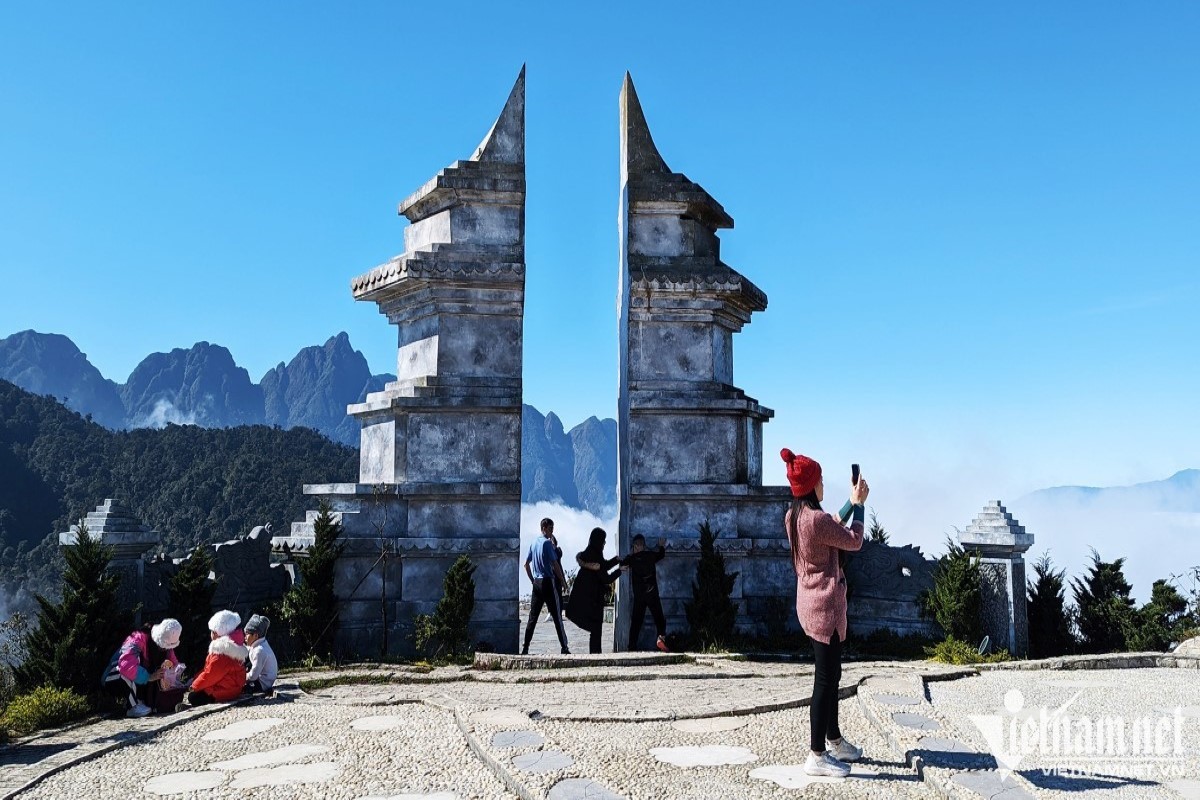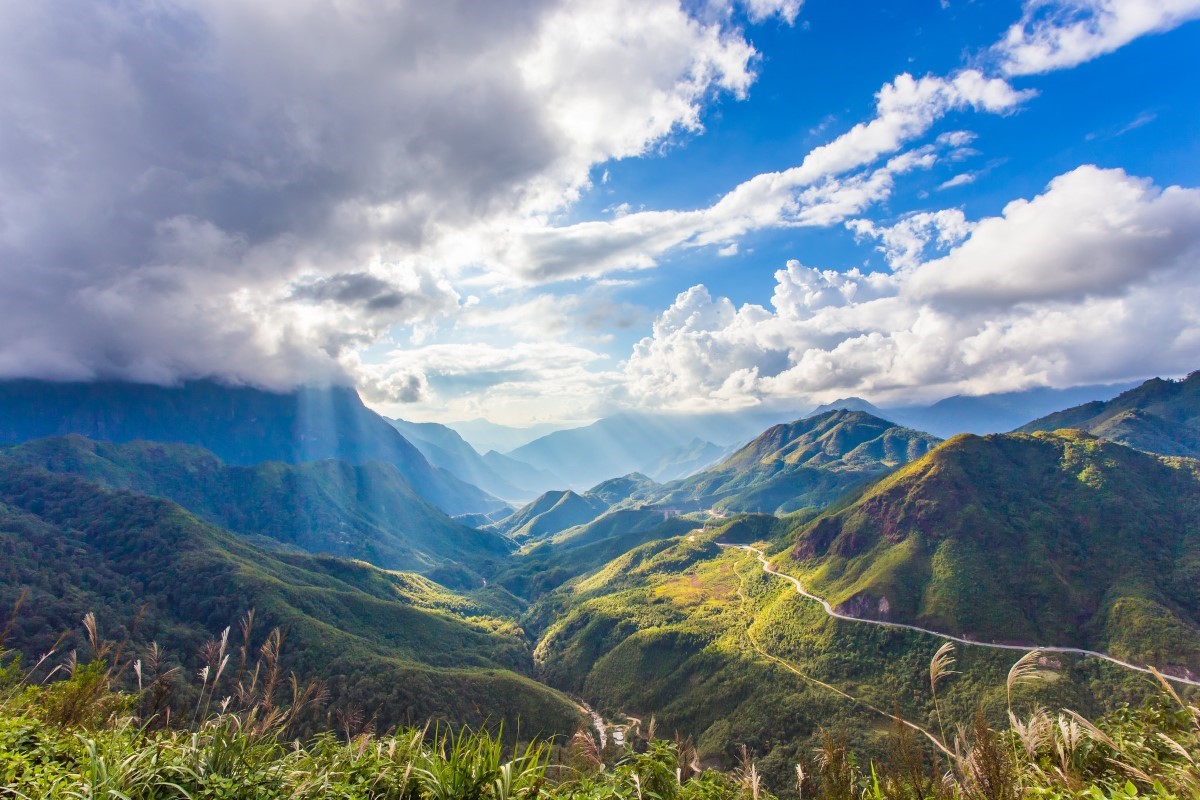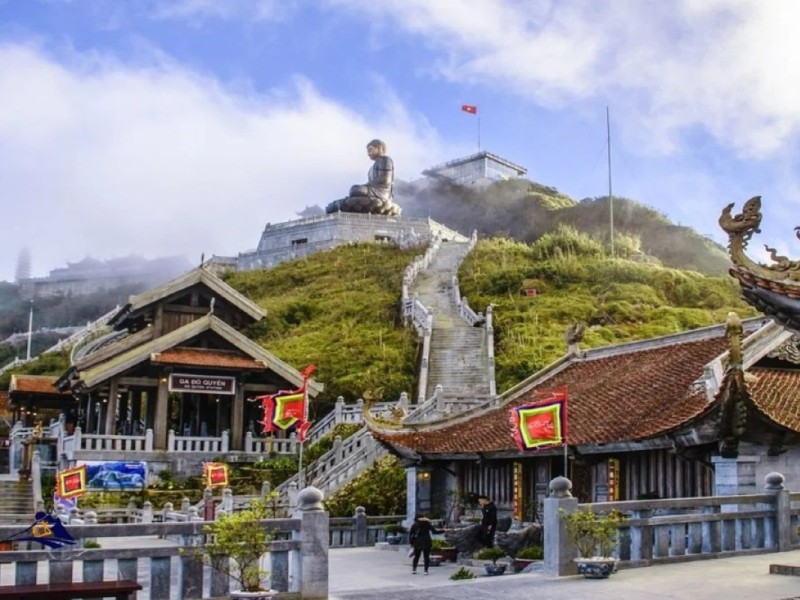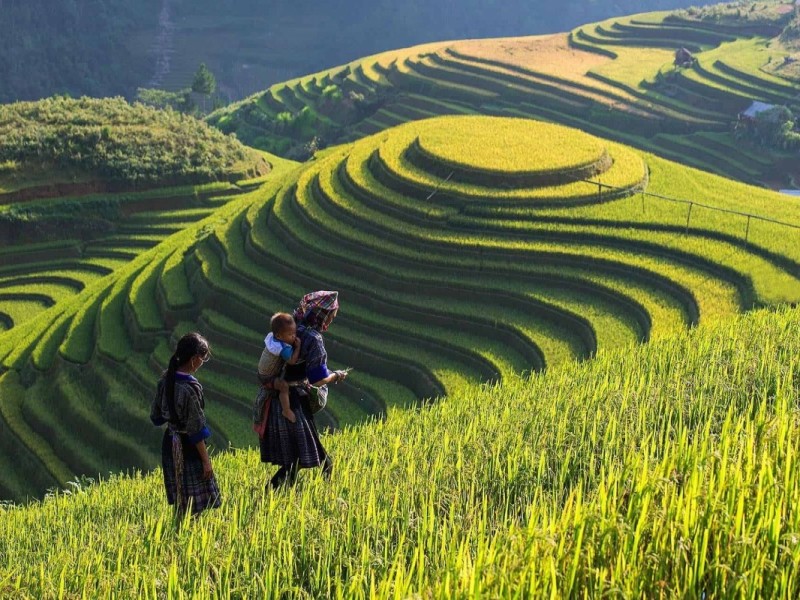Muong Hum Market: Explore the Authentic Heart of Lao Cai's Culture
Muong Hum Market Sapa is a vibrant weekly highland market where ethnic minorities gather to trade fresh produce, handicrafts, and local goods. Set in the mountains near Sapa, this authentic market offers a unique cultural experience, colorful traditional attire, and genuine interactions with local communities, far from typical tourist crowds.
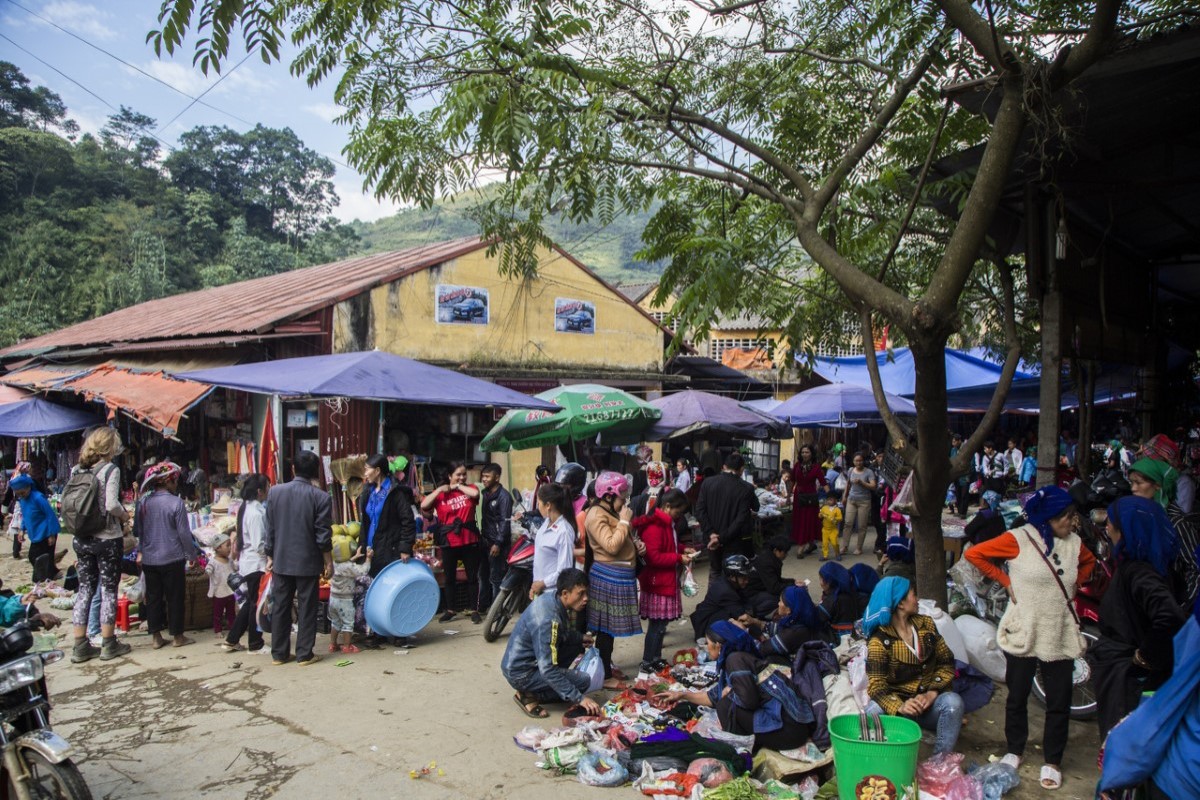
Welcome to Muong Hum Market – A Glimpse into Sapa’s Hidden Gem
Step into Muong Hum Market Sapa and you’ll find yourself surrounded by a world far removed from the usual tourist circuits. Nestled in the lush highlands of Sapa, Vietnam, this authentic Sapa market offers an experience that feels both timeless and untouched. The journey alone, winding through misty mountains and remote valleys, sets the mood for what’s to come—a market day full of color, spirit, and genuine hospitality.
Here, the air is thick with anticipation as dawn breaks and the first vendors arrive. Unlike the crowded stalls of central Sapa town, the market hums with local life rather than tourist chatter. Muong Hum Market Sapa stands apart for its deep roots in local tradition, where each gathering is more than commerce—it's a weekly celebration of culture and connection. There’s a real sense of being let in on a secret: the rare chance to witness a hidden gem Vietnam without the distractions of mass tourism.
Everywhere you look, traditions run deep. Ethnic minorities arrive before sunrise, some trekking for hours, dressed in vibrant, hand-embroidered clothing that reflects their heritage and pride. Their laughter and voices rise above the gentle river that snakes past the village, adding to the sensory tapestry of the scene. Stalls spill over with fresh mountain vegetables, handmade textiles, herbal remedies, and the scent of sizzling snacks drifting on the morning breeze.
What sets Muong Hum Market Sapa apart is not just its remoteness or its range of unique goods, but the powerful feeling that you’re witnessing something truly local—a Muong Hum unique experience that remains faithful to its roots. The unspoiled nature of this market makes every visit feel special, especially for those seeking genuine human connection and rare insight into highland culture.
If you’re looking for an off-the-beaten-path market or crave a taste of authentic Vietnam experiences, this is where you’ll find it. Let yourself be drawn in by the colors, the sounds, and the extraordinary sense of community that defines this remote minority market. Ready to discover one of Sapa’s most memorable, least-discovered treasures? Start planning your visit to Muong Hum Market Sapa and experience the highlands as few outsiders ever will.
Curious about what truly makes this place stand out from other Sapa markets? Read on to uncover the distinctive features and local secrets that set Muong Hum Market apart—and see why it belongs at the top of your must-see list.
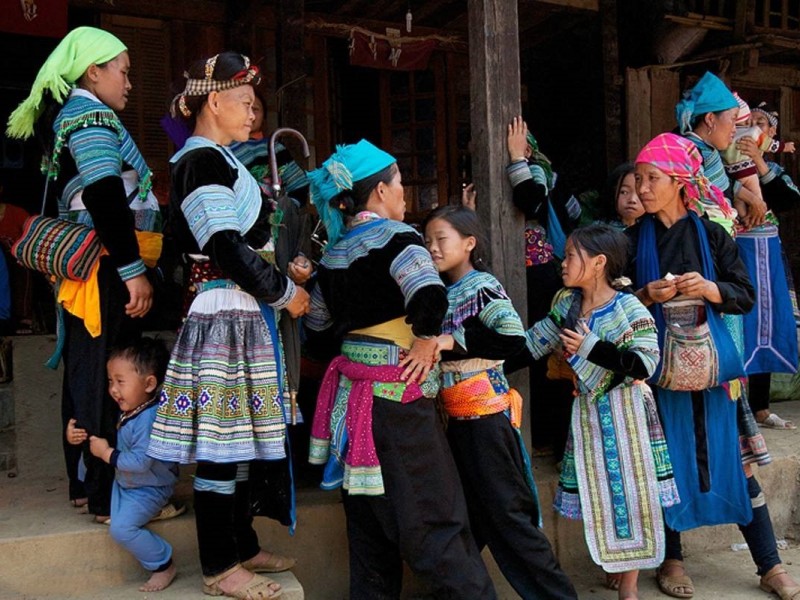
What Makes Muong Hum Market Special?
Ask any local in Sapa and you’ll hear that Muong Hum Market is unlike any other in Vietnam. For travelers wondering why visit Muong Hum market, the answer starts with its spectacular, out-of-the-way setting. Far from the busy heart of Sapa town, the market is set in a serene valley, surrounded by forested hills and rice terraces—giving it an air of discovery few markets can match.
What truly distinguishes Muong Hum Market is the gathering of diverse ethnic communities every Sunday. Hmong, Dao, Tay, Giay, Nung, Pa Zi, and Hoa people arrive from remote mountain villages, each group adding their own traditions, colors, and dialects. This weekly gathering is not just a shopping event, but a chance for families and friends to reconnect, share news, and preserve age-old customs.
Unlike other markets, you won’t find crowds of tourists or aggressive vendors here. Instead, the experience is refreshingly genuine. Local farmers lay out homegrown produce, women sell intricately woven textiles and silver jewelry, and livestock are traded in a lively, open-air corner of the market. Transactions are based on trust, tradition, and the rhythm of highland life—reminding visitors what an authentic Sapa market can feel like when left untouched by commercialization.
In any comparison—Muong Hum vs. Sapa town—the atmosphere here wins out for authenticity, warmth, and its palpable sense of community. This is a place where traditions endure, making it one of the region’s most undiscovered markets Vietnam for those who crave a window into genuine rural culture.
If you’re ready to trade tourist crowds for local encounters, or simply want to see how market day in rural Vietnam has looked for generations, make Muong Hum Market your next stop. Discover the spirit of Sapa at its most sincere—and don’t miss the chance to experience a true cultural celebration that still belongs to the people who call these mountains home.
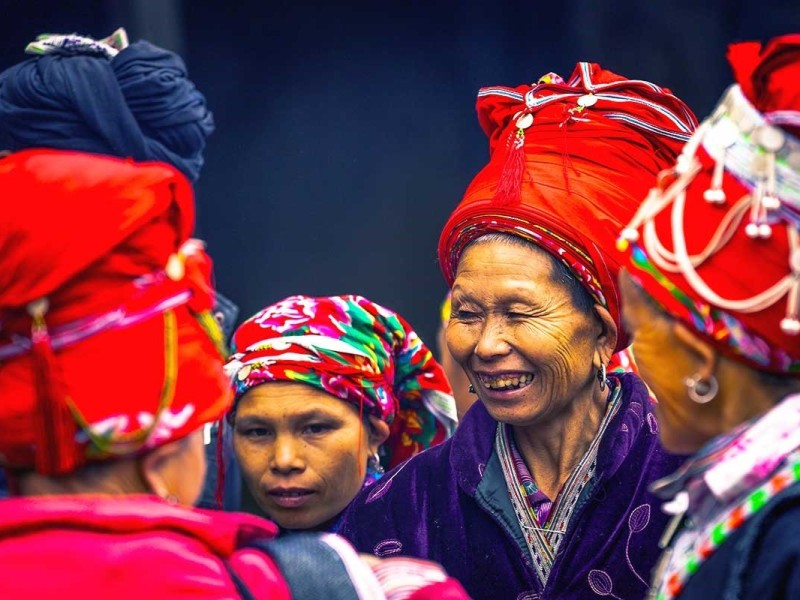
The Unique Blend of Cultures at Muong Hum
One of the most captivating reasons travelers flock to Muong Hum Market is its vibrant cultural tapestry. The true magic lies in the Muong Hum ethnic diversity you’ll witness—each Sunday, this crossroads transforms into one of the most authentically multicultural gatherings in all of northern Vietnam. In the heart of the mountains near Sapa, dozens of different traditions and dialects mingle as friends and strangers greet each other with warmth and curiosity.
Unlike many Sapa cultural markets that have become more commercial, the atmosphere here remains genuinely friendly and open. You’ll watch as families from the Hmong, Dao, Tay, Giay, Nung, Pa Zi, and Hoa groups share laughter and stories while trading goods, food, and news. Each community brings its own unique spirit—reflected in the variety of traditional crafts, foods, and social rituals you’ll see at every turn. These Vietnam tribal markets create a mosaic of color, sound, and experience you simply can’t find anywhere else.
If you value cross-cultural discovery, a stroll through Muong Hum Market is a rare chance to witness and respectfully participate in the coming together of Sapa minorities. Every visit offers new encounters and moments of genuine connection—making this market an essential stop for anyone seeking depth, authenticity, and a real window into ethnic life in rural Vietnam.
Curious about who you’ll meet and what customs you’ll observe? Read on for an up-close look at the fascinating ethnic groups and their distinct traditions at the heart of Muong Hum Market.
Ethnic groups you’ll meet
At Muong Hum Market, you’ll encounter a diverse blend of communities, each adding something special to the market’s energy. Here’s a look at the main ethnic groups and their roles:
- Hmong: Renowned for their bright, hand-embroidered clothes, the Hmong in Muong Hum are often early arrivals. Many women sell indigo-dyed textiles and silver jewelry while men bring livestock for trade.
- Dao: Easily spotted by their striking red headscarves, the Dao people Sapa contribute beautiful embroidery and herbal remedies. They’re known for warm greetings and bustling family stalls.
- Tay: The Tay tribe market sellers often offer bamboo handicrafts, baskets, and freshly harvested vegetables, their calm manner reflecting a long tradition of bartering.
- Giay: Recognized by colorful sashes and headwraps, the Giay bring unique rice-based foods and share tales of community history.
- Nung: The Nung are admired for their dyed clothing and vibrant woven goods, often displayed at the edge of the market.
- Pa Zi: Less numerous but proud, the Pa Zi contribute rare crafts and intricate metalwork, often alongside relatives from neighboring villages.
- Hoa: Of Chinese descent, the Hoa bring a unique flavor with dried goods, medicinal roots, and specialty snacks.
Arriving before sunrise, these ethnic groups transform the market into a living showcase of ethnic groups Sapa. Each brings their own customs, products, and traditions—making every visit to Muong Hum Market a fresh lesson in the cultural richness of Sapa and northern Vietnam. Connecting with these communities deepens the sense of adventure, so arrive early and bring a spirit of curiosity.
Wondering what makes each group visually stand out? The next section reveals the intricate details and stunning attire that color every corner of the market.
Local traditions and colorful attire
The visual richness of Muong Hum Market is unforgettable, thanks to a dazzling display of traditional dress and customs. As you wander the lanes, you’ll find yourself surrounded by living artistry—every group’s attire tells a story.
- Muong Hum traditional dress: Bright indigos, deep reds, and hand-stitched patterns are everywhere. Clothing is not only functional but symbolizes identity, heritage, and pride.
- Ethnic costumes Sapa: Each community’s outfit features distinct embroidery, metallic accents, and unique layers. Women wear elaborate skirts, sashes, and beaded headdresses, while men opt for simpler tunics or jackets.
- Vietnamese tribal attire: Intricate hairstyles (coils, buns, decorative combs), chunky silver jewelry, and dyed fabrics set each group apart and offer endless photo opportunities.
- Traditional embroidery Sapa: Many families display embroidered scarves, jackets, and bags—perfect souvenirs and reminders of ancestral skills.
- Ceremonial wear and cultural practices: On festival days or for special occasions, costumes become even more elaborate. Keep an eye out for processions, blessings, or group dances.
Photographers will delight in the kaleidoscope of colors and textures at Muong Hum Market. Always ask before snapping portraits, as many visitors are eager to share the story behind their attire and may even invite you to learn more.
The unique artistry and sense of belonging woven into every garment offer not just visual beauty, but a window into the region’s soul. Let your camera and your curiosity guide you—this is where unforgettable images and memories are made.
Bottom of Form
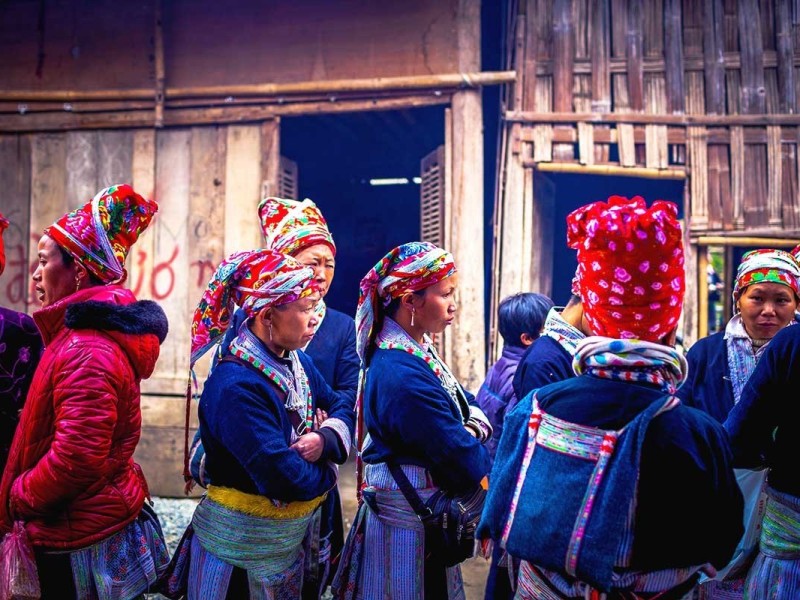
A Brief History of Muong Hum Market
To truly appreciate Muong Hum Market Sapa, you need to understand its place in the long tapestry of highland life. The history of Muong Hum market stretches back generations—long before the region became a draw for travelers seeking authenticity. Perched near the ancient mountain trade routes, the market began as a humble gathering point for ethnic minorities. It served as the beating heart of commerce, social news, and survival for remote communities across the Sapa region.
Over time, what started as a simple exchange of food, livestock, and hand-forged tools grew into an institution. The Muong Hum market origin is rooted in the spirit of cooperation and resilience. For many, market day was—and still is—a lifeline: the place to trade rare goods, barter for necessities, and connect with relatives from distant villages. In a landscape shaped by rugged terrain and shifting seasons, the market became more than a commercial center. It was the stage for celebrations, alliances, and the passing down of family traditions.
The traditional trade routes Sapa once followed are now echoed by the familiar paths leading to Muong Hum Market Sapa every week. As you wander through the crowd, you become part of a legacy that has witnessed colonial struggles, cultural renewal, and the slow but steady arrival of modern life in rural Vietnam. Here, Sapa market history is not just found in old stories—it lives on in every transaction, every shared smile, and every weathered hand.
If you’re drawn to places with soul, where commerce is woven with custom and history feels tangible, you’ll feel at home at Muong Hum Market Sapa. Let’s trace how this extraordinary market has evolved through the decades.
How the market started and evolved over time
The transformation of Muong Hum Market Sapa mirrors the resilience of highland communities. Here’s how the market has developed:
- Early Barter System: In its earliest days, villagers practiced a true barter system Sapa, exchanging rice, livestock, salt, and handwoven goods without money.
- Growth as a Regional Hub: As ethnic trade increased, the market became a vital stop along old mountain paths, linking remote hamlets to Sapa and even cross-border traders from China.
- Adaptation to Change: Over decades, the market absorbed new goods, money-based trade, and expanded stalls—yet the core spirit remained neighborly and local.
- Cultural Preservation: Despite the rise of tourism elsewhere, Muong Hum Market Sapa retained its focus on community, with rituals and traditions carried forward each week.
- Modern Touches: Recent years brought small conveniences like motorbike parking and cell phone stalls, blending the evolution of Sapa markets with time-honored rhythms.
From the barter system to today’s thriving weekly event, Muong Hum Market Sapa stands as a symbol of adaptation, heritage, and rural strength in Vietnam.
This living tradition reminds every visitor that markets are more than transactions—they’re crossroads of memory, resilience, and renewal.
Stories and legends from the local community
What truly sets Muong Hum Market Sapa apart are the stories whispered beneath its canvas awnings. Locals recount Muong Hum local stories of hidden treasures found after storms, or of chance meetings that led to lifelong friendships. According to Sapa market legends, the original site was chosen after a shaman’s dream—guiding villagers to a spot said to offer protection from both wild beasts and floods.
There are tales of traders who traveled for days with their buffalo, only to return home richer in stories than in silver. In the quiet corners of the market, elders pass on ethnic folklore Vietnam, describing how the spirits of the forest bless the first deal struck each Sunday. These oral traditions Sapa keep market day magical: parents still remind children that good luck follows those who greet strangers with a smile.
Such legends aren’t just quaint—they anchor Muong Hum Market Sapa in the hearts of its people and ensure that each visit is layered with memory, myth, and meaning. Whether you believe in market spirits or not, the sense of wonder is real.
The best way to discover these tales? Pause, listen, and let the rhythm of rural Vietnam reveal its secrets.
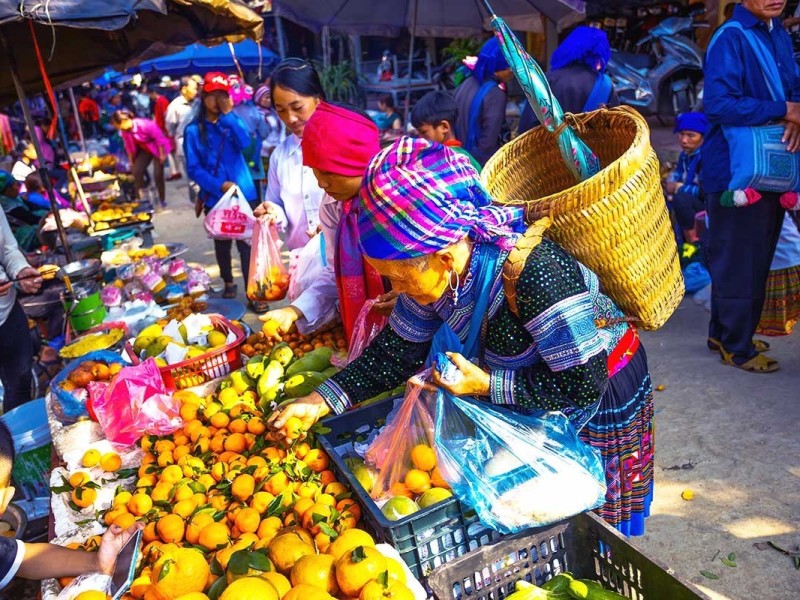
Essential Pre-Trip Planning & Logistics
Before setting out for Muong Hum Market Sapa, take a few moments to plan ahead—this small investment pays off with a stress-free adventure. Whether you’re a seasoned explorer or heading to the mountains for the first time, a thoughtful approach means you’ll spend less time worrying and more time soaking in the vibrant scenes of Sapa, Vietnam.
Start with your Muong Hum travel checklist: research the weekly market schedule, check seasonal weather, and note local customs. Knowing the basics ensures you’re prepared for the market’s remote location and changeable mountain climate. Keep your itinerary flexible—market days are lively but rural travel sometimes brings delays. Consult trusted sources, such as Asia Travel Links, for up-to-date logistics, booking help, and honest advice.
Smart planning is more than packing a bag; it’s about understanding what makes this experience special. By learning what to expect, respecting the local rhythm, and preparing for surprises, you’ll find the confidence to enjoy Muong Hum Market Sapa at your own pace.
If you want extra peace of mind, reach out to us at Asia Travel Links for real-time updates and on-the-ground tips. Take your first step towards an authentic, unforgettable market day—review the essentials, pack smart, and prepare to be amazed.
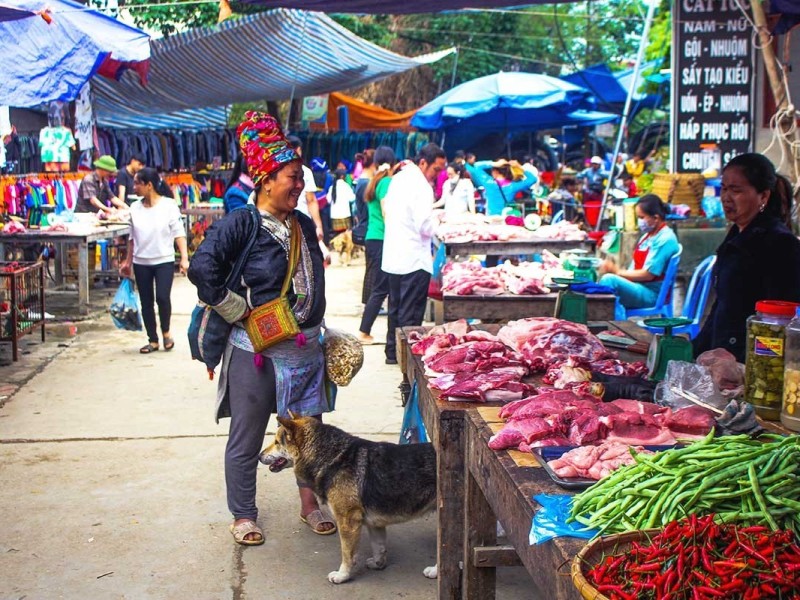
Packing Smart for Muong Hum: What Experienced Travelers Recommend
For a smooth visit to Muong Hum Market Sapa, thoughtful packing is key. The market’s location in the northern mountains means that weather can change quickly, and terrain can be muddy or uneven. Here’s a tried-and-true Muong Hum packing list from experienced travelers who’ve braved everything from misty dawns to lively crowds.
First, ask yourself what to pack for Sapa market trip by considering the season. For summer, bring lightweight rain gear and a sun hat. In winter, pack warm layers—a fleece jacket, wool socks, and a hat are must-haves. No matter the time of year, wear sturdy, comfortable shoes. The paths around the market are rarely paved and can get slippery. A small backpack is useful for carrying water, snacks, and any market finds. For those planning to stay longer or venture to nearby villages, a power bank, flashlight, and basic first aid kit are invaluable.
Don’t forget Sapa weather clothing. Mountain mornings can be chilly, while afternoons warm up quickly. Breathable fabrics and layered outfits work best for adapting to sudden shifts. In all seasons, bring sunscreen, insect repellent, and a lightweight scarf—it comes in handy for sun, wind, or extra modesty around local elders.
Here’s a checklist to keep your packing on track:
- Rain gear for summer: A compact rain jacket or poncho keeps you dry in sudden showers.
- Warm layers for winter: Fleece, gloves, and a hat protect against cold winds.
- Sturdy footwear: Grippy shoes or boots are essential for wet or uneven terrain.
- Small backpack: Perfect for water, snacks, and purchases from the market.
- Sun protection: Sun hat, sunscreen, and sunglasses help at high altitude.
- Personal health items: Hand sanitizer, tissues, any necessary medications.
- Seasonal extras: Lightweight scarf (summer), thermal base layer (winter).
Being prepared ensures you’re comfortable and free to wander. There’s no better way to experience the lively, sensory-rich world of Muong Hum Market Sapa than knowing you’ve packed right.
If you want a personalized packing list based on the season of your visit, email us at Asia Travel Links. We’re always happy to share practical, up-to-date tips for every traveler.
Chloe's Essentials: What I Wished I Packed (and Didn't!) for Muong Hum
Most packing lists are just that—lists. They tell you what to bring, but rarely why or, more importantly, what it truly feels like when you realize you've left something crucial behind in the wild, beautiful expanse of Northern Vietnam. My trip to Muong Hum Market, nestled deep in the Sapa region, was an incredible journey of discovery, but it also came with a few "Aha!" moments of packing regret that I'm eager to share, so your adventure can be even smoother than mine.
The anticipation leading up to Muong Hum was palpable. I'd read about its authenticity, its untouched charm, a Sunday market where ethnic minorities from surrounding mountains gathered, not for tourists, but for their own vibrant trading. My mental image was clear: misty mountains, colorful attire, bustling energy. My physical packing, however, was a little less precise. I envisioned light, breezy travel. Vietnam in July, right? Tropical. What I didn't fully grasp was the sheer realness of Muong Hum – its elevation, its unpaved paths, and the dynamic mountain weather that changes its mind faster than a market vendor on a slow day.
Our journey started from Sapa town, winding through emerald-green rice terraces that clung impossibly to the hillsides. The air, initially humid, grew crisper with every climb, carrying the scent of damp earth and distant woodsmoke. I felt a surge of excitement, a genuine thrill of stepping off the tourist trail. But then came the first unexpected twist: a sudden, sharp drizzle. It wasn't a downpour, but a persistent, fine mist that clung to everything. My stylish, breathable sneakers, perfect for city walking, quickly became saturated. My light, quick-dry jacket, while good for a slight chill, offered little resistance against the pervasive dampness. I immediately wished I had packed proper, waterproof hiking shoes and a more substantial, yet breathable, rain shell. The feeling of cold, damp socks squishing with every step as we navigated the muddy, uneven ground of the market was a constant, low-grade annoyance I hadn't anticipated.
The market itself was an explosion for the senses. The air hummed with a symphony of dialects, the rhythmic clanging of metal from a blacksmith's stall, and the distant bleating of livestock. The vibrant indigo and crimson of the Dao and Hmong women's clothing popped against the earthen tones of the stalls. I bought a small, intricately embroidered purse, feeling the rough texture of the hand-spun fabric, and sampled sticky rice cakes wrapped in banana leaves – sweet and earthy. My hands, however, were sticky, and I longed for a simple hand sanitizer. My phone battery, constantly snapping photos and videos, began to dip precariously low, and my portable charger sat uselessly back at the hotel in Sapa. I felt a pang of frustration, missing out on capturing moments like a Red Dao woman laughing heartily at my attempts to mimic her greetings. It was in these small moments of mild discomfort or missed opportunity that the packing lessons truly sank in.
One major insight gained was the sheer versatility required for mountain travel in Vietnam. It's not just about temperature; it's about precipitation, humidity, and the terrain. Expertise here means understanding that "tropical" doesn't equate to "always sunny and dry" at altitude. Authoritativeness, for me, came from squelching through mud and wishing I had grip, or staring at a beautiful scene with a dead phone battery, realizing the simplicity of preventative packing.
Here are my actionable practical takeaways from Muong Hum:
- Waterproof Footwear is Non-Negotiable: Forget stylish sneakers. Pack sturdy, waterproof hiking shoes or boots with good grip. The market ground, especially the livestock section, can be muddy and uneven, even on a clear day.
- Invest in a Proper Rain Shell: Not just a light jacket. A truly waterproof, breathable rain shell will be your best friend against sudden mountain drizzles or downpours. It also doubles as a windbreaker.
- Always Carry Hand Sanitizer and Tissues: You'll be touching goods, sampling food, and interacting with animals. Running water isn't always readily available.
- Portable Charger for Your Phone/Camera: This is a must. Muong Hum is incredibly photogenic, and you won't want to miss a single moment due to a dead battery.
- Small Daypack/Crossbody Bag: Keep your valuables secure and hands-free. A small, lightweight bag allows you to navigate crowded stalls easily.
- Small Denomination Vietnamese Dong (VND): Transactions are often for small amounts, and larger notes can be harder to break. This facilitates smoother bargaining and quicker purchases.
- A Sense of Humor and Openness: While not a physical item, this is the most crucial "pack" of all. Be prepared for the unexpected, embrace the sensory overload, and engage with genuine curiosity.
My adventure to Muong Hum was profoundly enriching, a true highlight of my Vietnam trip. It opened my eyes to the daily lives and vibrant cultures of the ethnic communities in a way that Sapa town couldn't. It taught me invaluable lessons, not just about packing, but about the joy of stepping outside your comfort zone and embracing the beautiful messiness of authentic travel.
Recommendation: If you're seeking a genuinely immersive, culturally rich experience far removed from the typical tourist crowds, Muong Hum Market is an absolute must-visit. Just remember to pack smart, learn from my "mistakes," and get ready for an unforgettable Sunday in the mountains!
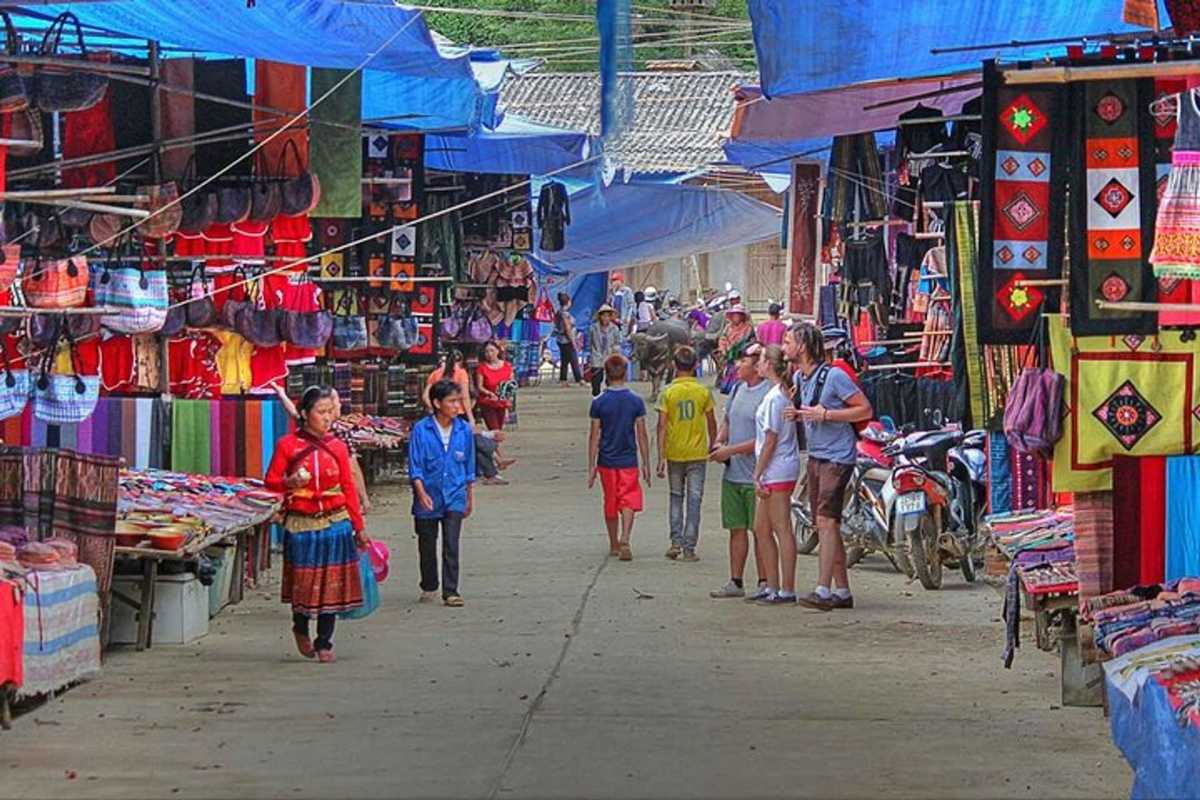
Muong Hum for Families: Kid-Friendly Activities & Considerations
Visiting Muong Hum Market Sapa with kids is a unique adventure—just be prepared for a few quirks along the way. If you’re traveling to Muong Hum with children, expect a lively, colorful market with friendly faces and plenty to see, taste, and touch. While this is not a stroller-friendly destination (unpaved, uneven paths are the norm), the sights and sounds keep children engaged, making it a great place for hands-on cultural discovery.
Parents searching for family travel tips Sapa will find that flexibility is your best ally. Bring easy snacks and a reusable water bottle—there are local treats, but picky eaters may prefer familiar favorites. Let children observe animals at the livestock area (always from a safe distance) or spot the bright costumes of ethnic groups moving through the crowd. Market mornings are best for families, as things are less hectic and the air is cooler. Simple games, sketchbooks, or a camera help fill downtime and make the visit even more interactive.
Here are the most important kid-friendly Sapa activities and tips for families:
- Animal watching: Children love seeing water buffalo, pigs, and chickens up close (supervised, never to touch).
- Sampling local snacks: Try sticky rice, sweet potatoes, or fresh fruit from friendly vendors.
- Photo fun: Encourage kids to snap pictures of colorful costumes or help them spot traditional hats and baskets.
- Friendly local children: While language can be a barrier, gestures and smiles go a long way in forging connections.
- Break time essentials: Carry a blanket or mat for impromptu picnics in shaded corners—markets can be busy, and rest is important.
While the bustle and unfamiliar foods may be overwhelming at first, most families find that the rich culture and warm welcome make for lasting memories. Preparation and a spirit of adventure turn this from a simple outing into a story your children will remember.
If you want more detailed advice or help planning your visit to Sapa, Vietnam as a family, email us at Asia Travel Links for our latest family-friendly tips and custom itineraries.
The Taylors' Adventure: Making Muong Hum Fun for the Whole Family
"Are we there yet?" The classic road trip chorus from the back seat, even as the emerald tapestry of Sapa's rice terraces unfolded outside the window, seemed to greet us on our journey to Muong Hum Market. As parents to an energetic 7-year-old, Leo, and his inquisitive 4-year-old sister, Mia, my husband Mark and I knew that visiting an authentic, less-touristy market like Muong Hum would be a different kind of challenge and a unique adventure. Most markets we'd experienced were sensory overloads, but we were determined to make this a memorable "Muong Hum family visit review" for our adventurous little explorers.
Our expectations were a mix of excitement and mild trepidation. We envisioned the vibrant colors, the sounds of trade, and the chance to truly connect with local culture, but also worried about keeping two young children engaged in a bustling, unfamiliar environment for several hours. As we left the more developed Sapa town behind, the winding mountain road, though a little bumpy, became part of the adventure. The kids were captivated by the dramatic landscapes, pointing out tiny houses perched precariously on hillsides and buffalo grazing in terraced fields. The fresh, crisp mountain air was a welcome change, carrying hints of damp earth and distant cooking fires.
Upon arrival, the market hit us like a wave of pure, unadulterated life. The scent of cooking food – roasted corn, savory herbs – mingled with the earthy smell of livestock. The sound was a symphony of human voices, animal noises, and the occasional clang of metal. Mia, initially a little overwhelmed by the sheer number of people, clung to my hand. Leo, however, immediately spotted the livestock section. "Look, Dad, a piglet!" he shrieked, his eyes wide. This was our first unexpected win: the "zoo" factor. We spent a good fifteen minutes just observing the chickens clucking in baskets, the sturdy ponies waiting patiently, and the occasional grunting pig. It was an instant hit, providing endless fascination and a natural, interactive learning experience that far surpassed any book or screen. This was a true "family-friendly Muong Hum activity."
The next challenge was hunger, and this became an opportunity for sensory immersion. We ventured into the food stalls, where vibrant piles of fresh produce and tempting local snacks beckoned. We let Leo and Mia pick one item each they wanted to try. Leo, ever the brave one, chose a sticky rice cake, its subtle sweetness a surprise. Mia, more cautious, settled for some perfectly ripe bananas. The vendors, seeing our children's curiosity, often offered a friendly smile or a small gesture, creating warm, genuine interactions that made us feel welcomed, not just like tourists. We learned that the "traveling with kids to Sapa markets" mantra isn't just about managing logistics; it's about embracing the spontaneity and allowing your children to lead some of the discovery.
One moment that truly stands out was when Mia, fascinated by the intricate embroidery on a Hmong woman's skirt, timidly reached out to touch it. Instead of recoiling, the woman, with a kind smile, gently lifted a corner of her fabric, allowing Mia to feel the texture. It was a silent, beautiful exchange that transcended language, a powerful lesson in cultural respect and connection for our kids. We encountered a momentary challenge when Leo got a bit overstimulated by the noise and crowds. Our solution? A quick retreat to a slightly quieter edge of the market, where we sat on a low wall and shared some local sugarcane juice, allowing him to recalibrate and re-engage at his own pace. Having a familiar snack and a designated "quiet spot" was a game-changer.
My biggest takeaway, the real "Sapa travel hacks from experience" for families, is that Muong Hum isn't just a place to observe; it's a place to participate in whatever way your family feels comfortable. The expertise we gained wasn't from a guidebook, but from watching our kids navigate this new world, learning what delighted them, and adapting on the fly.
Here are our actionable practical takeaways for families visiting Muong Hum:
- Embrace the Livestock Area: It's an instant attraction for kids. Allow them time to observe the animals; it's genuinely fascinating and can be a great icebreaker.
- Budget for Small Treats: Let kids choose a local fruit or snack. This gives them agency and introduces them to new flavors in an exciting way.
- Bring Small Toys/Distractions: For moments when overstimulation kicks in, a small toy car or a coloring book can provide a much-needed quiet break.
- Wear Comfortable, Sturdy Shoes for Everyone: The ground can be uneven and muddy. Good footwear prevents tired, grumpy feet.
- Pack Wipes and Hand Sanitizer: Essential for sticky fingers after trying snacks or interacting with animals.
- Teach Simple Greetings: Even a simple "Xin chào" (hello) or "Cảm ơn" (thank you) can open doors to friendly interactions with locals.
- Go with the Flow: Don't try to see everything. Let your kids' curiosity guide your exploration. The less structured, the more enjoyable it often is.
Our Muong Hum adventure wasn't just a visit to a market; it was a testament to the resilience and adaptability of our family. It forged new memories, sparked countless questions from our children, and left us with a deeper appreciation for the vibrant cultures of Vietnam. Seeing the world through their fresh eyes, encountering unexpected delights, and navigating small challenges together truly made it a family bonding experience we'll cherish forever.
Recommendation: For any family looking for an authentic, culturally rich, and incredibly rewarding experience in the Sapa region, I wholeheartedly recommend a Sunday visit to Muong Hum Market. It's an unforgettable journey that promises genuine connection, delightful discoveries, and a lifetime of shared stories.
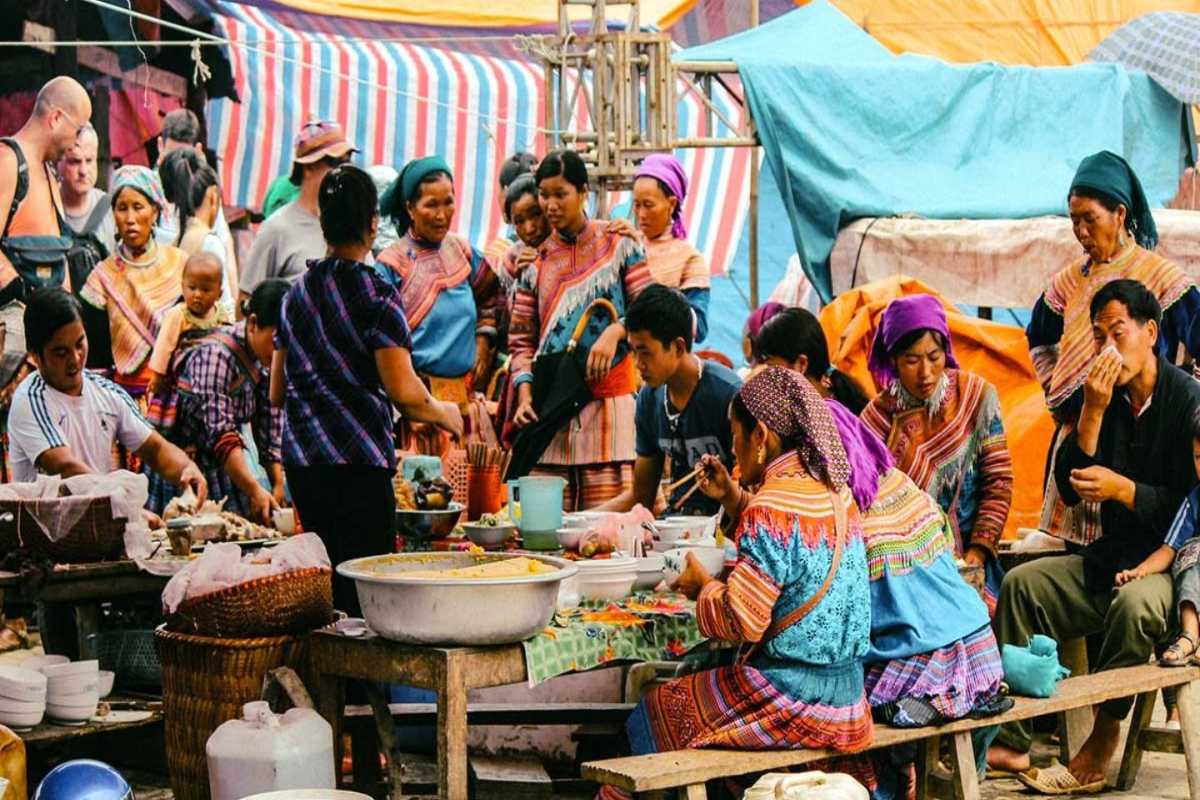
Safety First: Tips for a Secure Trip
Traveling to Muong Hum Market Sapa can feel like a true adventure, but staying safe is key to enjoying every moment. If you’re wondering is Muong Hum safe, rest assured: this remote market is generally peaceful, but it’s wise to prepare for crowded scenes, winding roads, and new food experiences. Pay attention to Muong Hum travel warnings and always prioritize your health and personal security.
Most travelers find the atmosphere welcoming, but like any busy spot, pickpockets can blend into crowds. Use a cross-body bag and keep your valuables in front. If you’re exploring after dark or taking side roads, stick with a group and use a reliable vehicle—road conditions can change quickly, especially after rain.
Here’s your quick Sapa safety guide and health checklist for Muong Hum:
- Protect your belongings: Carry only what you need, use zipped pockets, and avoid flashy jewelry.
- Be food smart: Stick to freshly cooked foods, avoid raw salads, and carry hand sanitizer for quick cleanups.
- Road awareness: Roads from Sapa, Vietnam can be narrow and winding—check weather forecasts and avoid night travel.
- Stay hydrated: Bring your own water or buy sealed bottles; avoid local tap water.
- Emergency contacts: Know the number for local police, tourist support, and your country’s embassy or consulate.
By taking these simple precautions, you’ll stay healthy, confident, and free to enjoy the market’s sights and sounds. If you have questions about personal safety or need trusted local contacts, reach out to Asia Travel Links for updated advice and on-the-ground support.
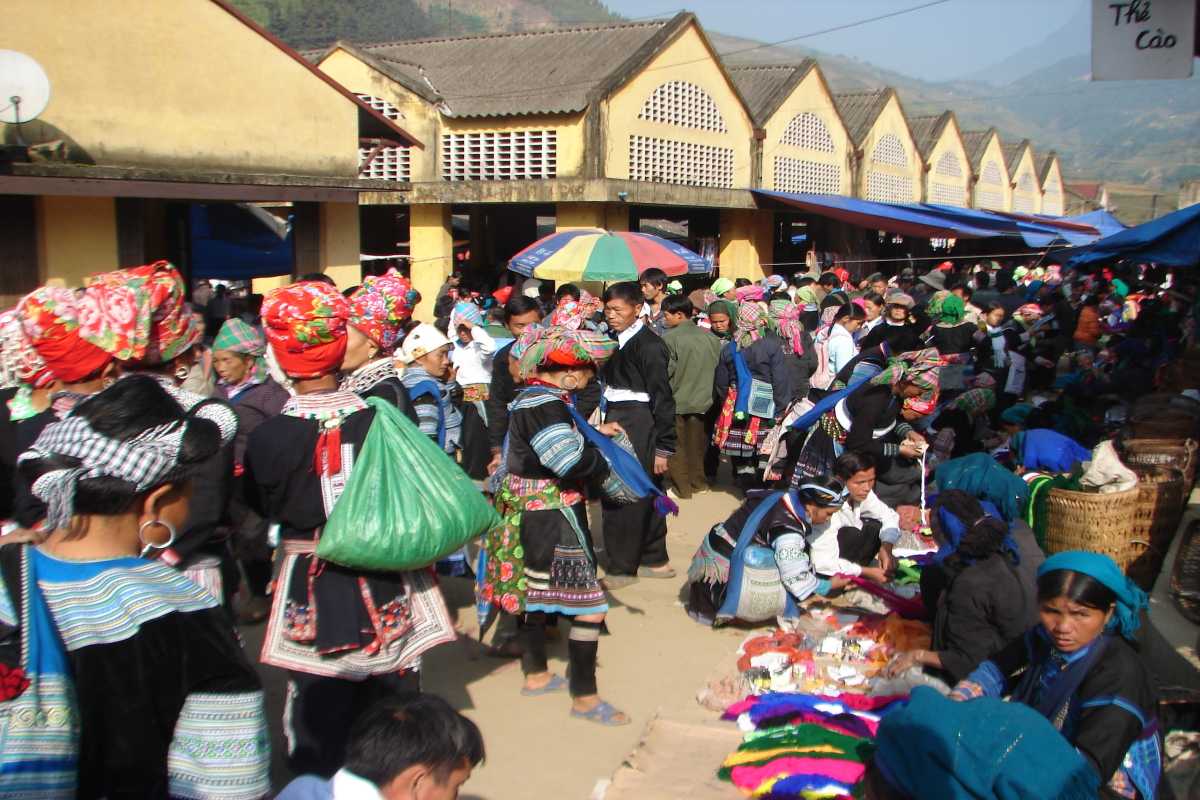
Planning Your Visit – How to Experience Muong Hum Like a Local
If you want your trip to Muong Hum Market Sapa to feel authentic, relaxed, and truly rewarding, a bit of smart planning goes a long way. This Muong Hum visitor guide shares exactly how to get to Muong Hum, when to visit for the best atmosphere, and all the local logistics you need for a smooth, worry-free adventure. Whether you’re coming from Sapa, Lao Cai, Hanoi, or elsewhere in Vietnam, use these practical tips to maximize your time and immerse yourself in the true rhythm of the market. For more help with transport or local bookings, you can always connect with Asia Travel Links.
Every visitor wants a seamless journey and genuine experience. Let’s walk through the details that will help you plan like a local, so your market day is effortless, colorful, and full of discovery.
No matter your starting point, this guide helps you experience the journey and destination with local insight. To start your planning or arrange a personalized itinerary, feel free to email us or reach out to Asia Travel Links for friendly, local advice.
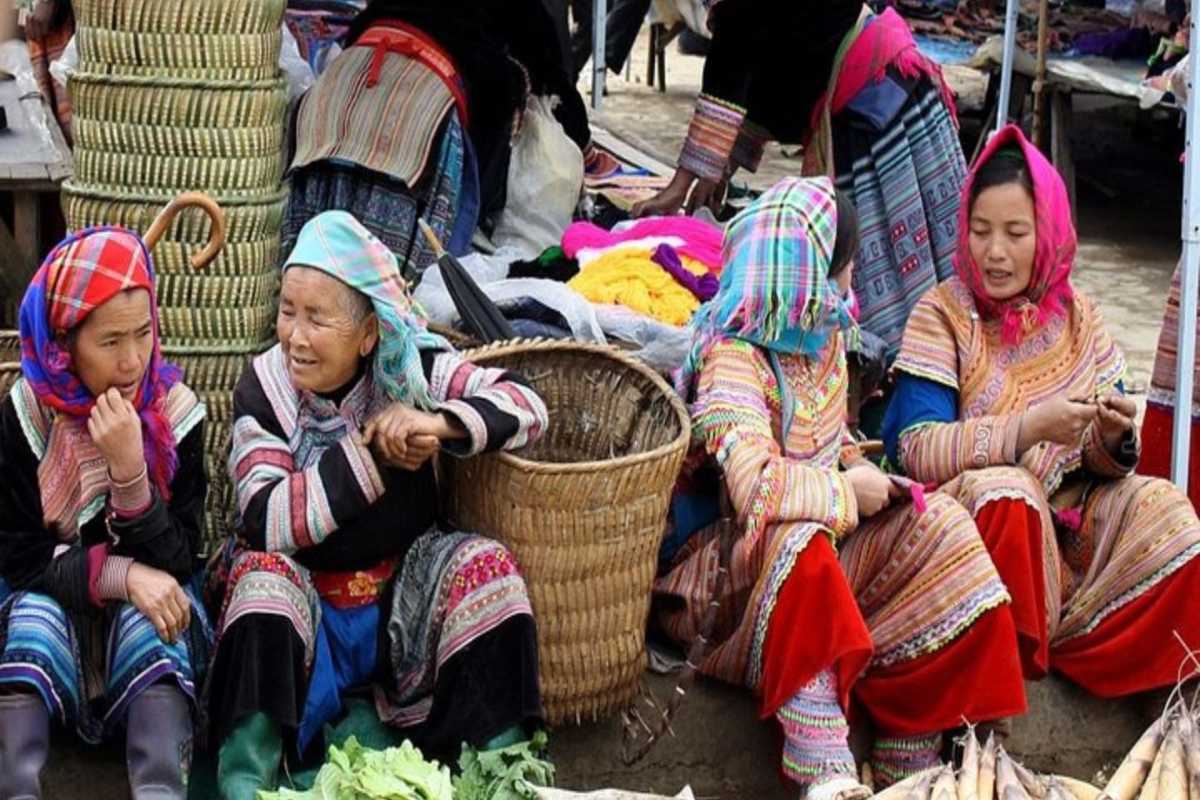
When and How to Get There
For the most vibrant Muong Hum Market Sapa experience, timing is everything. The best time to visit Muong Hum is always Sunday, when the market comes alive with traders and shoppers from surrounding villages. If you’re planning your trip, know that these Muong Hum market days are special events in the Sapa region, drawing diverse ethnic groups for a weekly gathering that’s lively and rich with tradition.
Consider the seasons: The dry months from October to April are ideal for travel, with cool air and clear skies—perfect for exploring the market and nearby landscapes. The rainy season (May to September) brings lush scenery, but roads may be muddy and more challenging.
Visit on a Sunday to witness the market at its liveliest. If you arrive on other days, the village is quiet and charming, but you’ll miss the full market buzz. For festival lovers, ask around or check the Sapa market calendar for major events that add extra color to your visit.
To enjoy the best of Muong Hum, mark your calendar for a Sunday visit during the dry season and be ready to soak in every detail.
The best days and seasons to visit
To experience the legendary Muong Hum Market Sapa, plan your trip for Sunday—the only day the full market opens. Sundays are a celebration of color and culture, making it the true Muong Hum Sunday market.
- Sunday mornings: The entire region gathers at dawn; best for full immersion and people-watching.
- Dry season (October–April): Clear skies and comfortable temperatures—ideal for exploring, photos, and meeting locals.
- Festival periods: Look for major holidays on the Sapa market calendar like Tet (Vietnamese New Year) or post-harvest celebrations for even more cultural richness.
- Rainy season (May–September): Expect fewer crowds, but be prepared for slippery roads and afternoon showers.
- Peak season: Weekends in spring and autumn, when weather is mild and scenery is at its best.
Whenever you go, arriving early on Sunday ensures you don’t miss a moment of the authentic action and traditions. If you want festival dates or travel tips for specific times, Asia Travel Links is happy to help you plan your visit.
Transport options: from Sapa, Lao Cai, and beyond
Reaching Muong Hum Market Sapa is easier than you might expect. Here’s how to choose the best route and mode of travel from Sapa, Lao Cai, or even Hanoi.
- Private car or van: Fastest, most comfortable (1–1.5 hours from Sapa). Best for families or those seeking convenience; book through Asia Travel Links for a reliable driver.
- Motorbike: Adventurous and flexible, great for confident riders. The road from Sapa to Muong Hum is winding and scenic, but check the weather before you go.
- Shared minivan: Budget-friendly and sociable, available in Sapa town or arranged via local agencies.
- Local bus: The cheapest option, but with limited schedules and basic comfort. Departures from Lao Cai, with some services direct to Muong Hum.
- From Hanoi: Take a night train or bus to Lao Cai, then transfer to Sapa or directly to Muong Hum by car, van, or local bus.
Compare these options for the right mix of comfort, price, and adventure for your group. If you need tailored transport, we’re ready to book and advise.
Navigating Local Transport: Motorbikes, Buses, and Taxis
Once you arrive, getting around Muong Hum Market Sapa and its nearby areas is simple if you know your options.
- Motorbike rental: Available in Sapa and Lao Cai, with or without a driver. Helmets are required—check brakes and lights before renting. Ride slow on mountain roads, especially if wet.
- Local bus to Muong Hum: Reliable for travelers on a budget, but schedules are limited. Ask at your hotel for up-to-date times.
- Sapa taxi services: Taxis can be hired in Sapa for a round trip. Always agree on price before departing and confirm pickup time for your return.
- Negotiating fares: In rural areas, cash is king and bargaining is normal—be polite and clear about your route.
- Road safety: Mountain weather changes fast—carry a rain jacket and have a phone number for your driver or guide.
If you need help finding the safest, best-value transport, Asia Travel Links can arrange vehicles and trusted local guides to keep your journey worry-free.
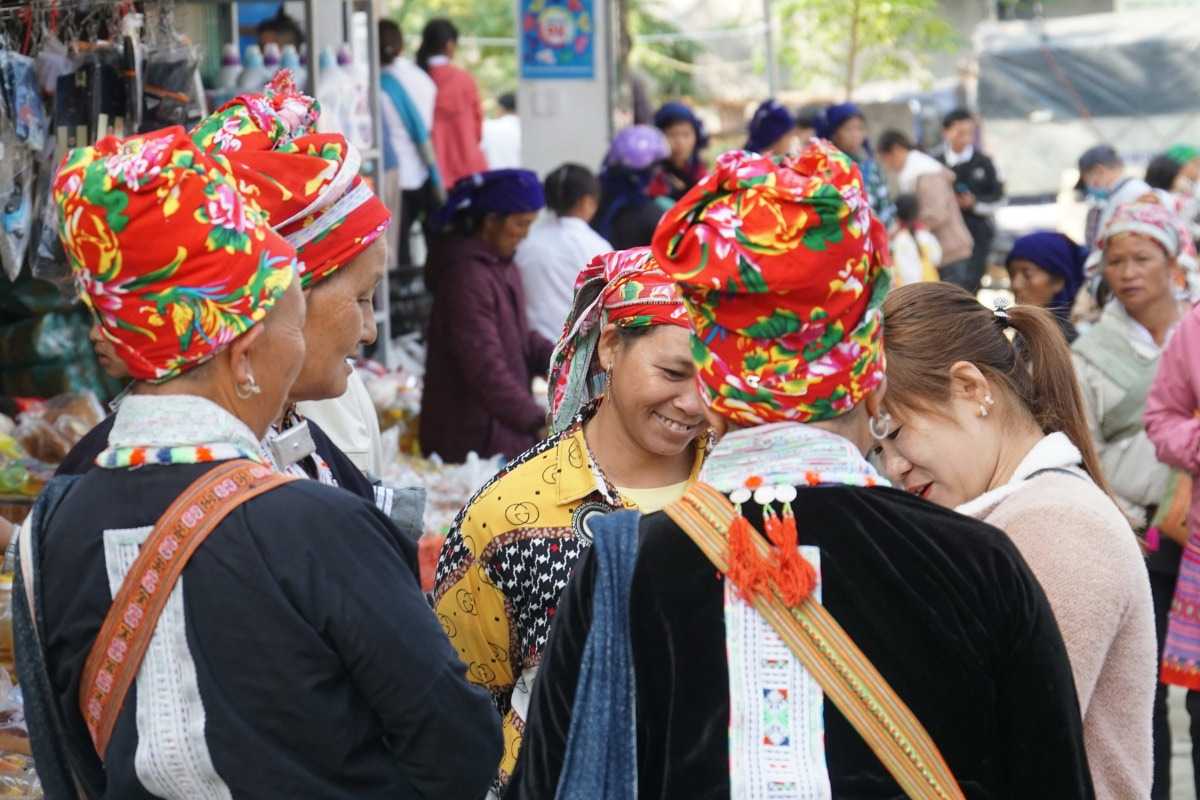
The Journey to Muong Hum: A Traveler's Perspective
Getting to Muong Hum Market Sapa is more than a drive—it's a true adventure. If you’re curious about the Sapa to Muong Hum travel experience, you’re not alone. Many travelers wonder what to expect on these winding mountain roads, and the reality is a mix of excitement, challenge, and reward.
My own journey began in Sapa on a cool, misty Sunday morning. With a rented motorbike, I set out early to beat the crowds and catch the market at its freshest. The first few kilometers were smooth, with wide views of terraced hills and tiny villages waking up in the dawn. As I left the main road, the ride got more interesting—some stretches were paved and easy, but others were bumpy, with sharp turns, occasional potholes, and unexpected patches of fog.
These Muong Hum road conditions can surprise even experienced riders. I learned quickly to slow down for sharp bends and always keep an eye out for local farmers and livestock on the move. For me, the highlight was the way the scenery shifted: bamboo forests, rice paddies, and rivers weaving through deep valleys. A sudden drizzle made things slippery, but the sight of buffalo grazing in the early mist made it all worthwhile.
If you’re not confident on a motorbike, it’s easy to hire a driver or take a shared minivan from Sapa. Both options let you relax and soak up the scenery—just be ready for a few jolts along the way. Locals are friendly and always happy to give directions or recommend a roadside food stall for a warm bowl of pho.
A few practical tips from my getting there story:
- Leave early in the day for the best light and to enjoy the market at its busiest.
- Bring a light jacket or raincoat—weather shifts fast in the mountains.
- Carry small cash for roadside snacks or emergencies.
- Download an offline map in case you lose phone signal.
Reaching Muong Hum Market Sapa felt like a real accomplishment. The journey was a little rugged, but it made arriving at the vibrant, bustling market even sweeter. Trust the ride, and let the road set the pace—you’ll discover stories and scenery you’ll remember long after you return.
Ready to start your own journey? If you’d like personalized travel tips or help with safe, comfortable transport, contact Asia Travel Links for local expertise and on-the-ground support.
Liam's Ride: Conquering the Sapa-Muong Hum Road
The idea of riding a motorbike from Sapa to Muong Hum wasn't just about getting there; it was about the journey itself. Most travelers opt for a private car or a shared van, and while that's practical, I wanted the raw, unfiltered "Muong Hum scenic drive experience." I craved the wind in my face, the unmediated scent of pine and damp earth, and the feeling of truly earning the destination. What I didn't fully anticipate was just how much of an adventure—and a test—that winding mountain road would truly be.
My expectations were set on breathtaking vistas and a sense of freedom. And for the most part, it delivered. Leaving Sapa town early on a Sunday morning, the air was cool and crisp, carrying the faint smell of woodsmoke from distant villages. The initial stretches of road were paved, carving through stunning terraced rice fields that gleamed like emerald staircases in the morning light. The quiet was profound, broken only by the hum of my motorbike and the occasional crow of a rooster. I felt an exhilarating sense of escape, a true Sapa Muong Hum motorbike trip review in the making.
However, the mountain roads in Northern Vietnam have a personality all their own. Around halfway, as I dipped into a valley, a thick, swirling fog descended with startling speed. Visibility dropped to mere meters, and the vibrant greens and blues of the landscape dissolved into a ghostly grey. My heart rate quickened. This was the first unexpected twist, a moment of genuine challenging roads Sapa presented. The road, which had been relatively smooth, also transitioned into gravel and unpaved sections, slick with recent rain. My tires struggled for grip, and I had to slow to a crawl, navigating blind corners with an almost reverent caution. The fog muted all sounds, creating an eerie, almost otherworldly silence that felt both isolating and strangely beautiful. My initial excitement morphed into a focused determination, a quiet triumph with every successfully navigated hairpin bend.
Then, just as suddenly, as I ascended again, the fog began to lift, peeling back like a curtain to reveal the grandeur of the Hoang Lien Son mountain range. The sensation was incredible – emerging from uncertainty into dazzling clarity. I stopped for a moment, the silence now filled with the distant sounds of the market below, a low murmur carrying on the breeze. The air smelled fresher, cleaner, hinting at the vibrant life waiting just around the bend. It was more than a drive; it was a sensory immersion – the chill of the fog, the scent of the wet earth, the rumble of the gravel, and finally, the breathtaking visual reveal. The personal resonance was profound: a journey that mirrored life's own twists and turns, rewarding perseverance with unparalleled beauty.
My main insight is that this route demands respect and preparation, but offers immense rewards for those seeking a deeper connection with the landscape. It's not just a means to an end; it's a significant part of the Muong Hum experience itself. The expertise I gained was less about navigation and more about understanding the temperament of mountain weather and roads.
Here are my actionable practical takeaways for others planning a similar journey:
- Check the Weather Meticulously: Mountain weather is unpredictable. Look for forecasts specifically for Muong Hum, not just Sapa. A clear day is ideal for visibility and safety.
- Rent a Reliable Motorbike: Don't skimp on quality. Ensure the bike is well-maintained, with good tires and brakes. Ask about its suitability for mountain terrain.
- Dress in Layers: Even if Sapa is warm, altitudes change quickly. Bring a warm base layer, a fleece, and crucially, a waterproof and windproof jacket. Gloves are also a good idea.
- Pack Essentials: A small backpack with water, some snacks, and a basic first-aid kit is advisable.
- Go Slow, Especially on Unpaved Sections: Prioritize safety over speed. Some parts can be gravelly, muddy, or have loose rocks.
- Be Mindful of Local Traffic: Expect livestock, pedestrians, and other motorbikes. Locals are accustomed to these roads, but visitors need extra caution.
- Portable Charger: Ensure your phone is fully charged and bring a power bank, especially if using GPS. Cell service can be spotty.
- Start Early: Gives you ample time, allows for unexpected delays, and lets you experience the changing light.
The ride to Muong Hum was a microcosm of adventure travel: moments of awe, unexpected hurdles, and the immense satisfaction of overcoming them. It deepened my appreciation for the destination tenfold, making the vibrant market feel like a hard-won prize.
Recommendation: For the adventurous soul seeking more than just a destination, for those who truly want to immerse themselves in the raw beauty of Northern Vietnam, I highly recommend Liam's Ride: Conquering the Sapa-Muong Hum Road by motorbike. It's challenging, exhilarating, and undeniably one of the most rewarding journeys I've ever experienced.
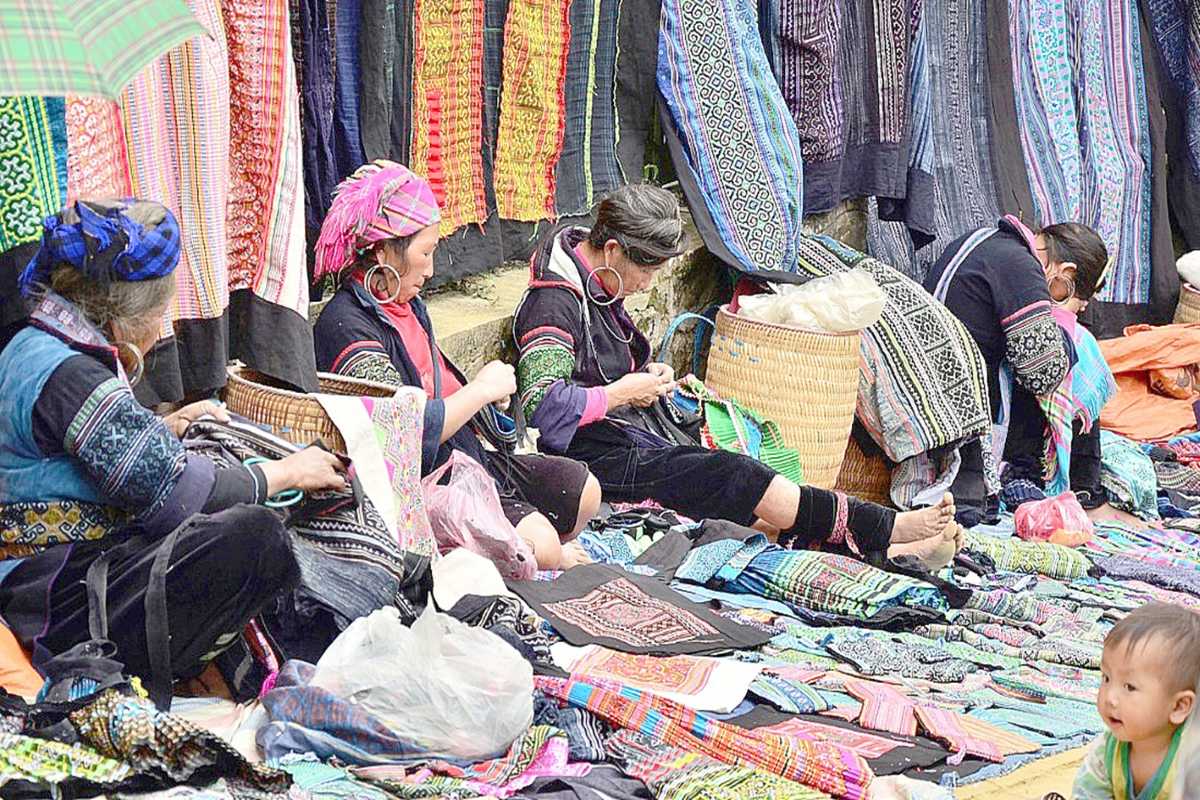
What You Need to Know Before You Go
Before you set out for Muong Hum Market Sapa, it’s essential to cover all your bases. Doing so means fewer surprises and more time to enjoy the journey. Make sure you understand the key Muong Hum travel requirements, stay on top of Sapa market preparation, and review a few smart Vietnam travel tips before departure.
First, check your passport and visa status. Most travelers to Vietnam require a visa—verify if yours is e-visa eligible, or if you need to apply in advance. Keep both digital and paper copies of important documents, as you may lose mobile signal in rural areas.
Stay healthy on the road. Bring basic medication for motion sickness, mild digestive issues, and mosquito protection. While the highlands are generally safe, drinking only bottled or boiled water is wise. If you have dietary restrictions or medical needs, pack what you need, as specialty products are hard to find.
Take note of local regulations and customs in ethnic minority areas. Always ask before taking photos of people, especially elders or those in traditional dress. Dress modestly to show respect. Some villages have specific customs—look for posted signs or ask your guide for advice.
Respect community boundaries. Stick to designated paths, and avoid wandering into private fields or homes unless invited. Being polite and open will help you receive warm welcomes from local residents in both Sapa and the surrounding region.
A few must-have items for your checklist:
- Passport, visa, and copies (digital/paper)
- Basic first-aid and prescription medications
- Travel insurance with coverage for mountain regions
- Cash in small denominations (ATMs are rare in the area)
- Emergency contacts (embassy, local guide, Asia Travel Links)
If you want up-to-date info on entry requirements, local regulations, or health advice for remote market travel, email us or reach out to Asia Travel Links for the latest updates and traveler support.
Essential travel tips for first-timers
Every trip to Muong Hum Market Sapa is unique, especially if it’s your first time. Start by managing your expectations—this is an authentic rural market, not a polished tourist site. Bring curiosity and patience; schedules may change, and plans might shift with the weather.
To help you feel prepared and culturally confident, follow these simple etiquette tips:
- Smile and greet vendors with a friendly “xin chao” (hello)
- Avoid haggling too aggressively—bargain gently, and accept when a price is fair
- Dress modestly and wear shoes you don’t mind getting muddy
- Always ask before taking someone’s photo, especially in traditional attire
- Be flexible and open to new experiences, foods, and encounters
Understanding Sapa cultural etiquette and respecting local customs will lead to warmer, more genuine interactions. Let go of rigid plans and embrace a little unpredictability—some of the best moments come when you least expect them.
If you have questions about cultural do’s and don’ts or want to connect with a local guide, reach out to Asia Travel Links for traveler-friendly advice and tips.
Weather, what to pack, and how to prepare
Weather in Muong Hum Market Sapa shifts with the seasons, and knowing what to expect helps you pack smarter and stay comfortable. Each month brings its own flavor—here’s what you need to know before you go.
- Spring (March–May): Mild temperatures, occasional rain. Bring a light rain jacket, layers for cool mornings, and sturdy shoes.
- Summer (June–August): Warm and humid, frequent afternoon showers. Lightweight, quick-drying clothes, a compact umbrella, and plenty of water are musts.
- Autumn (September–November): Dry, crisp air, beautiful harvest scenery. Ideal for walking, so add a hat, sunglasses, and a camera.
- Winter (December–February): Cold, misty, and sometimes damp. Pack warm layers, a thermal base, and gloves.
Always pack a small daypack for snacks, water, and your camera. Comfortable shoes are vital—expect dirt and mud, especially in the rainy season. If you’re sensitive to weather changes, bring a scarf or buff and a waterproof phone pouch.
Check a Sapa climate guide before you travel for the most accurate forecast. Whether it’s hot sun or chilly drizzle, being prepared lets you enjoy every corner of the market.
For help with packing lists or seasonal travel planning, contact Asia Travel Links. Our local experts can help you stay prepared, dry, and comfortable.
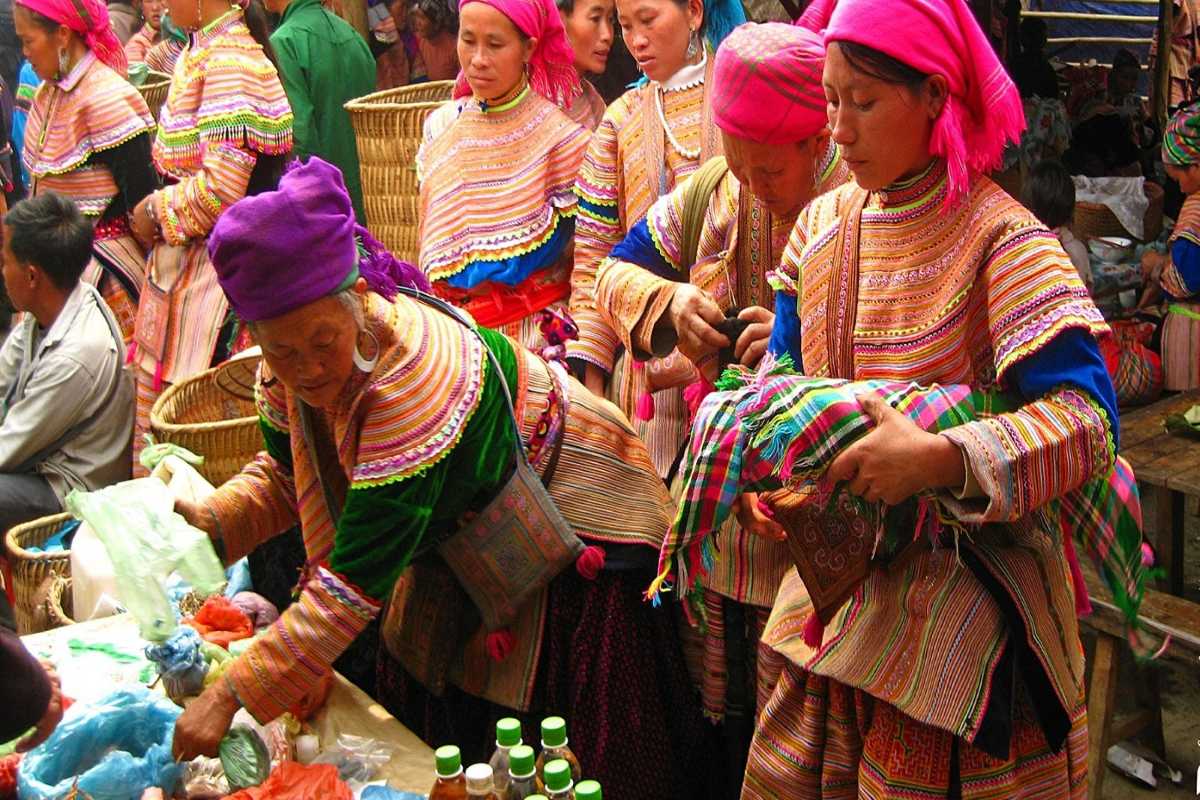
Entry, Costs, and Local Logistics
Before you arrive at Muong Hum Market Sapa, it’s wise to know exactly what to expect in terms of fees, local currency, and staying connected in a remote mountain region. Let’s make sure you’re prepared for every step—Muong Hum entrance fee information, common Muong Hum costs, and a quick breakdown of local logistics Sapa to avoid last-minute surprises.
Most travelers find that the market is free to enter, but certain parking or restroom facilities may carry a small fee (usually 5,000–10,000 VND). Bring cash—credit cards are not accepted, and ATMs are very limited. When it comes to spending, anticipate costs for transport, food, crafts, and the occasional extra (like a local guide or snack). Plan your budget around cash transactions for the smoothest experience.
If you need a detailed, printable cost breakdown or have questions about market logistics, email us at Asia Travel Links for tailored advice and current info.
Is there a fee?
Travelers often ask if there’s an entrance fee at Muong Hum Market Sapa. The good news is, the market itself is open to all, and there is no official Muong Hum market entrance fee. You can explore the entire market for free, absorbing the atmosphere and sights at no charge.
However, you may want to budget for:
- Parking fees if you arrive by car or motorbike (typically 5,000–10,000 VND)
- Paid public restrooms (3,000–5,000 VND)
- Special exhibitions or events on festival days (rare and always posted in advance)
- Optional contributions to local guides or craft demonstrations
The cost of visiting Muong Hum remains among the lowest in Sapa and is ideal for budget-conscious travelers. Knowing this lets you focus on enjoying the experience rather than worrying about unexpected charges.
For current event info or fee updates, Asia Travel Links can answer your questions anytime.
Currency, ATMs, and language basics
Managing your money and communicating clearly will make your visit to Muong Hum Market Sapa stress-free. The local currency is Vietnamese Dong (VND), and you should plan to bring enough cash for your entire stay. Muong Hum ATM access is extremely limited—there are no ATMs in the market area, and the nearest ones are in Sapa or Lao Cai.
Here’s how to avoid cash or language hassles:
- Bring plenty of small bills (10,000–100,000 VND notes are most useful)
- Don’t expect credit card acceptance—this is a cash-based market
- Count your change carefully; double-check amounts for larger purchases
- Learn a few Vietnamese phrases for market visits, like “bao nhieu?” (how much?), “cam on” (thank you), and “khong” (no, thank you)
A quick phrase list can help:
- Hello: Xin chao
- Thank you: Cam on
- How much?: Bao nhieu?
- Yes/No: Vang/Khong
- Delicious: Ngon
For more travel tips or a printable phrase card, email us for Asia Travel Links’ market-ready language guide.
Where to stay nearby: lodging options and local homestays
To fully experience the region, consider spending a night in a Muong Hum homestay or at an accommodation near Muong Hum market. You’ll find genuine hospitality, delicious home-cooked meals, and a real window into the daily life of Sapa’s ethnic communities.
Recommended stays:
- Homestays in Muong Hum itself—friendly, family-run, and affordable
- Guesthouses in Y Ty—spectacular mountain views, close to local trekking trails
- Village stays in nearby communities—choose a basic guesthouse or a more immersive ethnic lodging
- Booking is best arranged in advance via phone or with Asia Travel Links, especially during festivals or peak weekends
Authentic Sapa lodging is about more than just a bed—it’s about learning, sharing meals, and connecting with your hosts. Bring your own toiletries, be ready for rustic comforts, and enjoy the unique chance to slow down.
Want help booking a stay or need custom recommendations? Asia Travel Links can suggest trusted options and handle reservations for you.
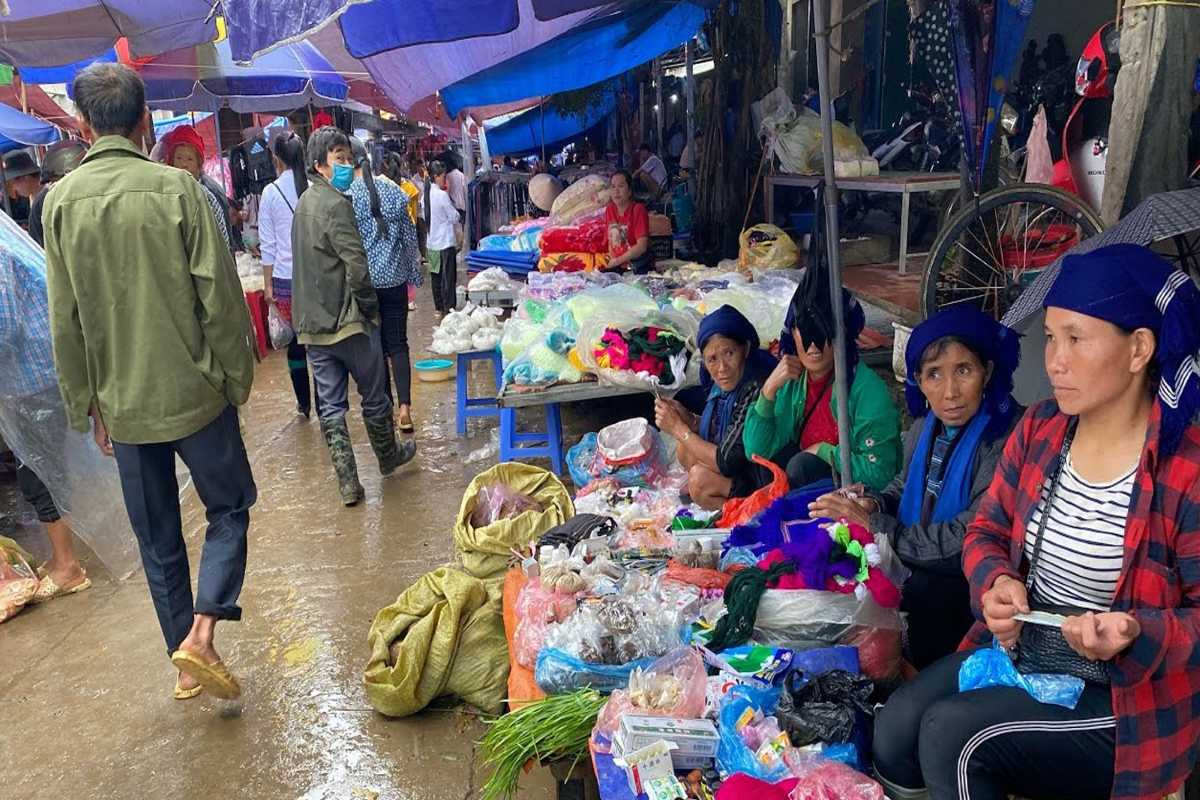
Discover the Market – Sights, Sounds, and Flavors
Wandering through Muong Hum Market Sapa is a true feast for the senses. As you step into the bustling square, the air hums with the rhythm of conversation, laughter, and the vibrant exchange of goods. The early morning sunlight flickers across stalls piled high with earthy produce, gleaming handicrafts, and steaming street food. Here, you’ll discover what makes the Muong Hum sensory experience so distinct—every sight, sound, and aroma captures the essence of Sapa’s remote highland life.
If you’re wondering what to see at Muong Hum, let your curiosity guide you through the lively pathways and let your senses lead the way. Exploring the market is more than shopping—it’s about tasting, touching, and connecting with local culture at every turn. Find a quiet corner and listen to the unique harmony that only a truly authentic market can offer.
Whether you’re a first-timer or a seasoned traveler, Muong Hum Market Sapa will draw you in and make you part of its vibrant story. To capture the most memorable moments, keep your camera ready and your mind open—each visit is a new discovery.
Ready to plan your own sensory adventure? Contact Asia Travel Links for the latest local insights and trip ideas.
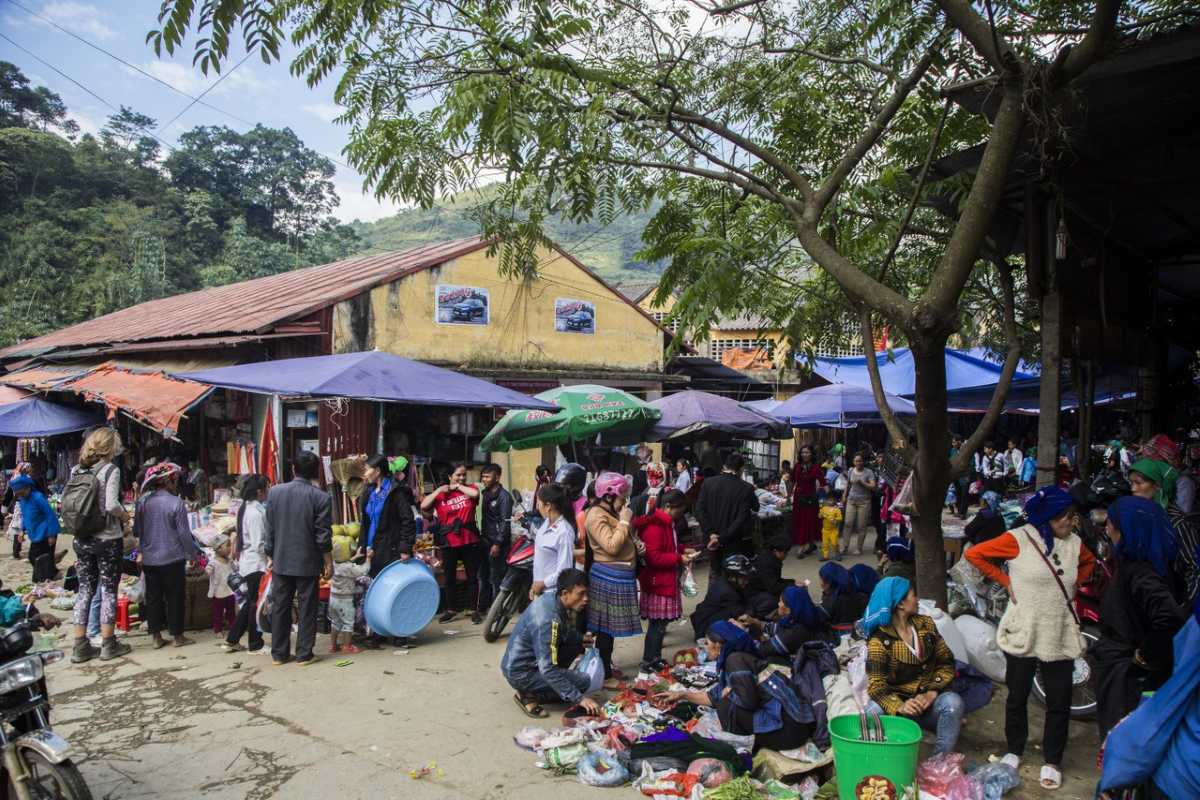
What You’ll Find at Muong Hum Market
From the moment you arrive at Muong Hum Market Sapa, you’ll be greeted by a dazzling array of sights and goods. The market is a treasure trove for anyone curious about Muong Hum market goods and the unique character of Sapa market products. You’ll find everything from household necessities to rare cultural items—each stall a small universe of color, texture, and tradition.
So, what to buy Muong Hum? Look out for the details—artisanal crafts, seasonal produce, and one-of-a-kind mementos make each visit worthwhile. The diversity ensures that every traveler can find something special to remember their journey by.
Ready to dive in? Walk slowly, ask questions, and let your senses guide your purchases—sometimes the most rewarding finds are those you never expected.
Local produce, handicrafts, and ethnic specialties
Curious about the variety at Muong Hum Market Sapa? Here’s what sets the market apart:
- Fresh mountain produce: Local vegetables, wild mushrooms, bamboo shoots, and fragrant herbs picked at dawn.
- Ethnic crafts Sapa: Intricately woven textiles, including hemp and indigo-dyed cloth, are a testament to the artistry of Sapa’s tribes.
- Hand-carved wooden items: Traditional kitchen tools, decorative pieces, and handmade toys carved by local artisans.
- Traditional Vietnamese goods: Classic baskets, lacquerware, and everyday essentials reflecting highland life.
- Unique forest ingredients: Wild honey, rare medicinal plants, and herbal teas sourced from the surrounding mountains.
Each item tells a story—crafted or gathered by hand, shaped by tradition and the land itself.
Exploring these treasures lets you appreciate the creativity and resilience of the communities around Muong Hum. Bring home something authentic and support local artisans with every purchase.
Finding the Perfect Keepsake: Specific Craft Recommendations
Choosing a keepsake from Muong Hum Market Sapa is about more than just picking up a souvenir—it’s a way to bring a piece of Sapa’s spirit home. Here’s how to find something truly special:
- Best souvenirs Muong Hum: Look for hand-embroidered scarves, traditional hats, or a hand-painted bowl made by local tribes.
- Authentic Sapa handicrafts: Verify origin with the seller—ask about their process and family history to avoid factory-made imitations.
- Muong Hum gift ideas: Consider silver jewelry, unique spice blends, or small wood carvings as thoughtful presents.
For the best value and authenticity, shop at stalls run by local families, not resellers. Quality pieces often have a maker’s signature or a unique touch—seek out those details for a more meaningful purchase.
Finding the perfect memento is all about connection—when you know the story behind the item, every glance at it will remind you of the market’s vibrant heart.
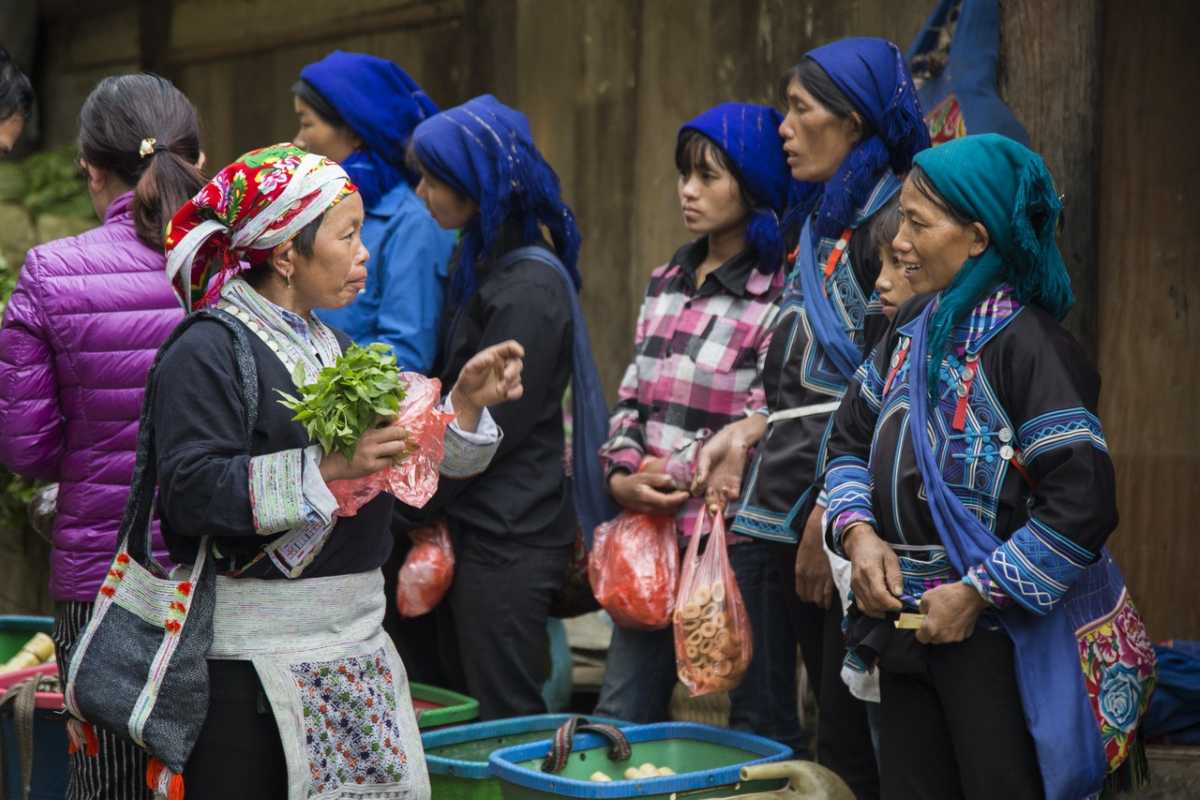
Muong Hum's Culinary Delights: A Taste Tour
When you visit Muong Hum Market Sapa, you’ll discover why food is at the heart of every memorable travel experience. This market is a true culinary playground, offering an array of street foods and family-run eateries that capture the soul of Sapa. If you’ve ever wondered about Muong Hum food or what to eat Muong Hum market, here’s a guide to tempt your taste buds and make each meal an adventure.
Wandering the alleys, you’ll notice sizzling grills, fragrant steam rising from cauldrons of soup, and tables crowded with locals tucking into their favorites. Each stall offers something different, from comforting bowls of pho to sticky rice with mountain herbs, revealing the rich variety of Sapa local cuisine. Let your senses lead you—often the most unforgettable dishes are found at the busiest stalls or the ones with the friendliest smiles.
To get the most out of your food journey, start early when everything is freshest. Don’t be afraid to ask what’s popular or watch what local vendors are preparing. You’ll discover flavors that are both familiar and entirely new, always cooked with pride and a sense of tradition.
Let the flavors of Muong Hum Market Sapa guide your visit—and if you’re looking for deeper culinary insights or special dining recommendations, email us at Asia Travel Links for local tips.
Sam's Foodie Journey: My Top 3 Must-Try Dishes at Muong Hum Market
Let's be honest, for me, travel is as much about what you eat as what you see. And when it comes to markets, the food stalls are where the real magic happens. Muong Hum Market, nestled in the Sapa region, isn't just a place to observe; it's a vibrant, aromatic symphony for the palate. Forget fancy restaurants; this is where authentic flavors truly sing. My Muong Hum food recommendations aren't just about deliciousness, but about the experience of connecting with the local culture through taste. If you're wondering what truly defines a Muong Hum street food review, let me share my top three unforgettable discoveries.
My journey into Muong Hum's culinary heart began almost immediately upon arrival. The air, already thick with the earthy scent of the mountains, was soon layered with the tantalizing aromas of grilling meat, simmering broths, and sweet, steaming rice. My mission was clear: find the most authentic, soul-satisfying dishes this hidden gem had to offer. I approached each stall with an open mind, a curious nose, and a ready appetite, often pointing and gesturing with a smile, which usually led to a warm response from the vendors.
1. Grilled "Cap Nach" Pork Skewers (Thịt Lợn Cắp Nách Nướng)
The first dish that absolutely captivated me was the grilled pork. You’ll find stalls with smoking charcoal grills, the scent of sizzling meat mingling with the sweet, almost nutty fragrance of burning wood. These aren't just any pork skewers; they're made from "Cap Nach" pigs, small, free-range pigs raised in the mountains. The meat is leaner, incredibly tender, and bursting with flavor.
I found my favorite at a bustling stall near the main entrance, identifiable by the sheer volume of smoke and the line of locals patiently waiting. The vendor, a cheerful woman with a colorful Dao headscarf, gestured for me to choose my skewers. The pork, marinated in a simple blend of local spices and herbs, was grilled to perfection – slightly charred on the outside, creating a delicate crispness, while the inside remained incredibly juicy. The smell of grilled pork was intoxicating, drawing me in from across the market. Each bite was a revelation: savory, smoky, with a subtle sweetness. I paired it with a handful of fresh herbs she offered – peppery coriander and a leafy green I couldn't identify, adding a refreshing contrast to the rich meat. This was easily a contender for the "best grilled meat in Muong Hum."
2. Bamboo Tube Sticky Rice (Cơm Lam)
Next on my foodie quest was something I'd heard whispers about: sticky rice cooked in bamboo. This is a staple in the highlands, and for good reason. It’s incredibly portable, simple, yet deeply satisfying. I spotted a vendor unwrapping segments of bamboo, revealing perfectly formed cylinders of glutinous rice, emitting a gentle, earthy steam. The texture of sticky rice in these was unlike any I’d had before – firm yet tender, each grain distinct but perfectly cohesive.
I purchased a tube from a quiet stall tucked away deeper in the market, where an elderly woman was meticulously preparing them over a small charcoal fire. The rice, subtly sweet, had absorbed the delicate aroma of the bamboo, giving it an almost woody, fragrant note. It was often served with a sprinkle of roasted sesame seeds and salt, enhancing its natural flavor. It was the perfect counterpoint to the richer grilled pork and a comforting, wholesome bite amidst the market's hustle. This is truly a Muong Hum must-have item for any foodie.
3. Local Noodle Soup (Often Unnamed, but Pho-like)
While specific "best pho in Muong Hum" might be a stretch as it's not a pho-centric market like Hanoi, I discovered a humble noodle soup stall that served up a truly remarkable bowl. This wasn't the refined pho of the cities; this was a rustic, hearty, soul-warming version, tailored to mountain appetites.
The stall was small, with only a few plastic stools, and a large pot of simmering broth bubbling away. The smell of fresh herbs and simmering bones wafted tantalizingly. I simply pointed to the bowl a local was enjoying. It arrived with thick, fresh rice noodles, tender slices of local beef or pork, and a generous scattering of fresh green onions and coriander. The broth was clear but incredibly flavorful, a warming elixir that chased away the lingering mountain chill. It was simple, honest, and profoundly delicious. This felt like a true "Muong Hum street food review" moment – discovering unpretentious, authentic local flavors.
Practical Advice for Your Foodie Adventure:
- Look for Busy Stalls: A crowd of locals is always the best indicator of good food and fresh ingredients.
- Don't Be Afraid to Point: If language is a barrier, pointing to what others are eating or directly at the ingredients you want is perfectly acceptable and common.
- Carry Small Denominations: Food items are often inexpensive, and having small bills (Vietnamese Dong) makes transactions smoother.
- Observe and Learn: Watch how locals eat and prepare their food. It's part of the cultural experience!
- Be Adventurous (within reason): While I didn't try the famous "Thang Co" (horse meat stew) on this trip, don't be afraid to step outside your comfort zone. You might discover a new favorite.
- Bring Wipes/Sanitizer: Eating street food can be a bit messy, so come prepared.
My Muong Hum foodie journey was an exhilarating exploration of taste and culture. Each dish told a story of the land and its people, leaving me with not just a satisfied stomach, but a deeper appreciation for the unique culinary traditions of this remote region. It’s not just about sustenance; it’s about connection.
Recommendation: For any traveler with a passion for authentic flavors and a desire to dive deep into local culture, your visit to Muong Hum Market is incomplete without embarking on your own foodie journey. Seek out the grilled pork, savor the bamboo sticky rice, and definitely find a comforting bowl of local noodle soup. Your taste buds will thank you, and you'll leave with a richer understanding of this incredible place.
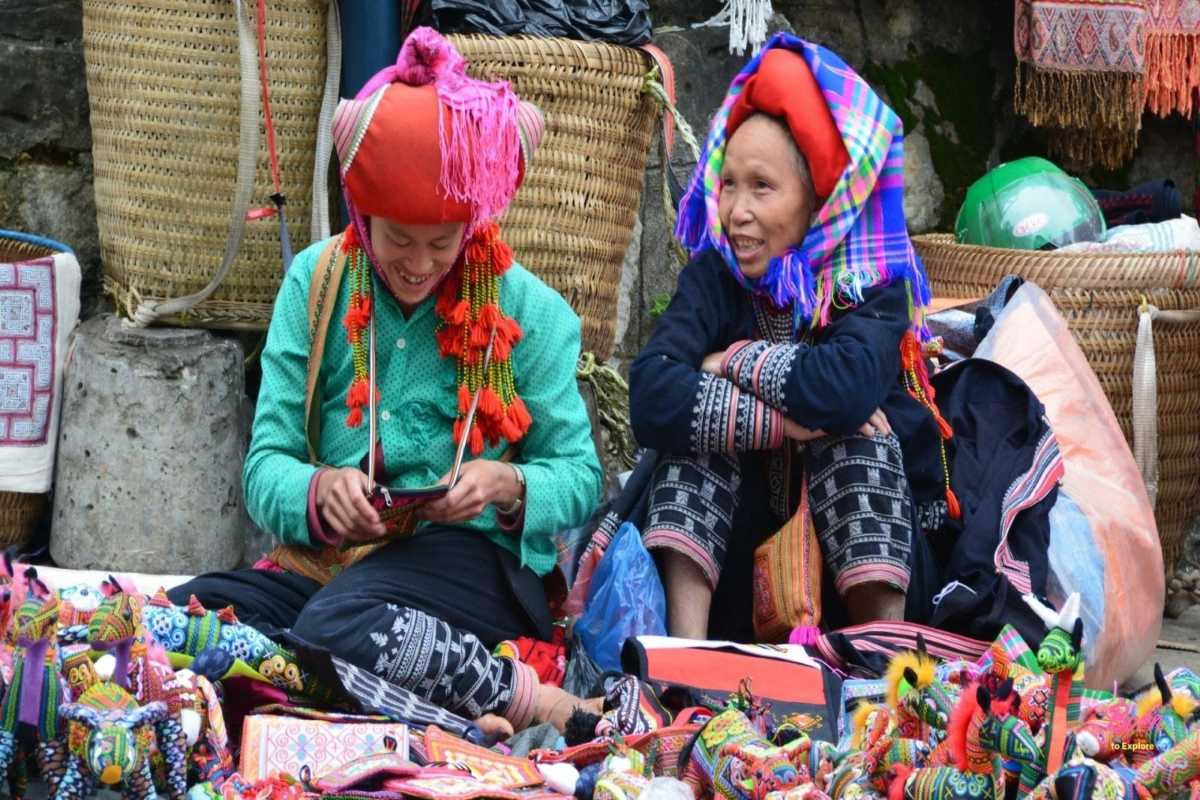
Don’t-Miss Experiences at the Market
If you’re eager for more than just shopping, Muong Hum Market Sapa is packed with Muong Hum market activities and moments of pure discovery. This isn’t a place to simply browse and buy—it’s where you can take part in unique experiences Sapa travelers rarely find elsewhere. Dive into true Muong Hum cultural immersion and come home with stories you’ll want to share.
- Witness the lively livestock section in action, where farmers from the surrounding hills bring buffalo, pigs, and chickens to trade at sunrise. This early morning ritual is a rare window into the rural rhythms of Muong Hum.
- Chat with friendly vendors—many eager to introduce you to the stories behind their wares or even demonstrate a craft technique. Each conversation is a step deeper into authentic Sapa culture.
- Taste seasonal fruits or fresh mountain herbs handed to you by local children—sometimes a single bite can transport you straight into the region’s agricultural heart.
- Join a spontaneous game of shuttlecock with market kids or try your hand at bargaining for a special keepsake.
- Observe impromptu music performances or traditional dances breaking out among vendors and shoppers. These aren’t staged shows, but a genuine part of market life.
To make the most of these moments, arrive early, keep your eyes open, and approach each interaction with curiosity and respect. The most rewarding market experiences come from being present and open to connection.
Ready to discover the full energy of Muong Hum Market Sapa? Let us know if you want personalized tips for your visit—email us at Asia Travel Links anytime.
The lively livestock market
Arrive before dawn and you’ll find the Muong Hum Market Sapa animal section already buzzing. The Muong Hum animal market is where farmers and herders gather to trade buffalo, pigs, and chickens—each transaction fueled by quick negotiation and years of local tradition. This is the heart of livestock trading Sapa, and for many, it’s the most authentic glimpse into rural life you’ll see all trip.
- Buffalo exchanges: The star attraction, drawing crowds for both the size of the animals and the size of the deals.
- Pig and chicken pens: Children help their families manage the smaller livestock, making it a family affair.
- Early morning energy: Arrive early for the most lively, crowded scenes—by late morning, most animals are sold.
- Tradition and respect: Observe quietly, give animals and farmers space, and always ask before taking photos.
- Local economy: This section underpins the market’s importance, supporting entire communities and local trade.
Witnessing this spectacle reminds visitors that livestock is more than a commodity here—it’s the foundation of family livelihood. The respect you show as a guest will be appreciated by everyone present.
For more tips on respectfully exploring Muong Hum Market Sapa and understanding the rural economy, reach out to us at Asia Travel Links.
Market rituals, performances, and traditional games
You never know when you’ll stumble upon a moment of magic at Muong Hum Market Sapa. Traditional music, impromptu dancing, or a quick game of shuttlecock are woven into the daily flow. Kids create their own playground among the stalls, while elders might chant prayers or share old folk tales before the trading begins.
- Morning rituals: Vendors often begin with prayers or blessings for luck and good sales.
- Musical interludes: Local musicians or vendors break out drums, flutes, or stringed instruments, filling the air with melody.
- Dance and movement: Festive days may see groups forming for circle dances—join in if you’re invited.
- Children’s games: Youngsters organize friendly matches of traditional games like spinning tops or shuttlecock.
- Storytelling: Find a quiet corner and you might hear elders sharing legends or tales from Sapa’s past.
Each of these experiences reveals a deeper layer of the market’s culture and social life. To participate or observe respectfully, simply follow the locals’ lead and ask questions with a smile.
If you’d like to know when special events or performances are likely during your visit to Muong Hum Market Sapa, contact us at Asia Travel Links for the latest insights.
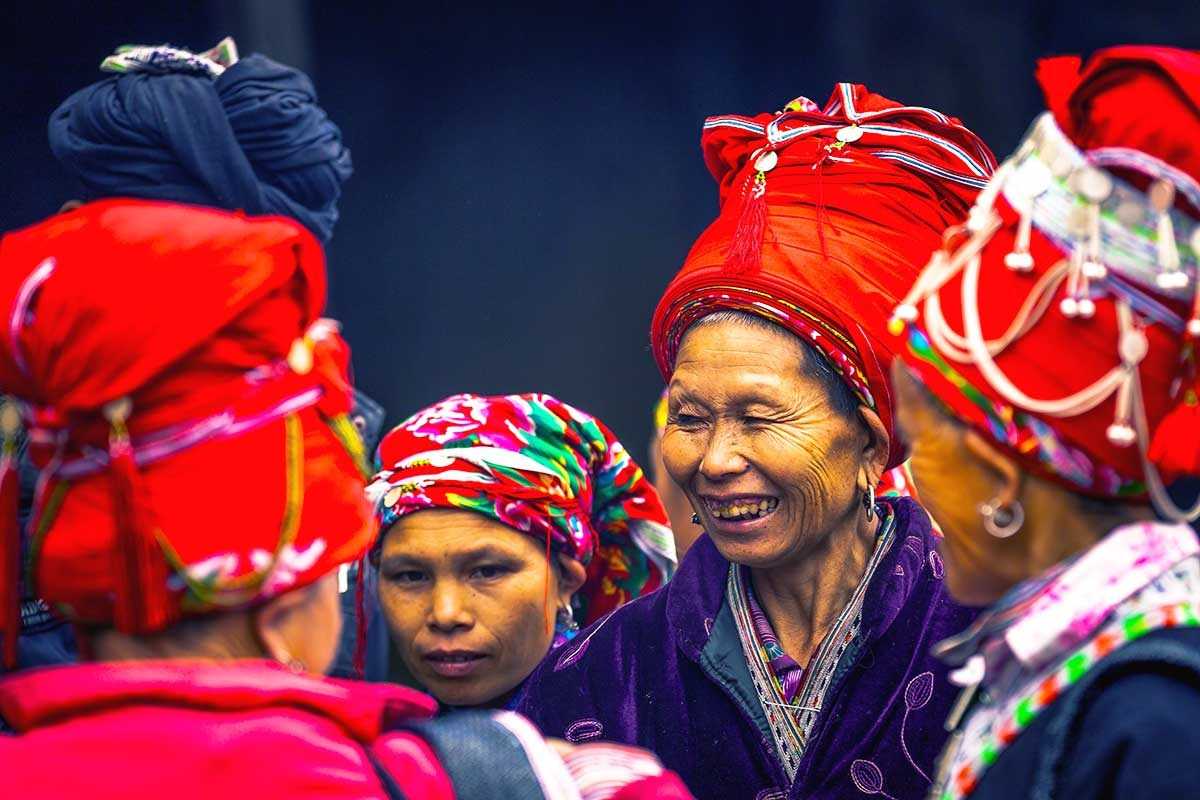
Mastering Market Bargaining: Insider Tips
Every traveler wonders how to bargain at Muong Hum Market Sapa without feeling awkward or offending anyone. Bargaining is part of the local culture—done right, it’s a lively exchange that benefits both you and the vendor. The best experiences come from blending confidence with cultural sensitivity and learning a bit of Vietnamese market etiquette before you go. Use these essential haggling tips Sapa to get a fair deal and enjoy the process:
- Start with a smile: A friendly approach builds trust and sets a positive tone.
- Watch and learn: Observe locals first. Note their body language and tone when bargaining.
- Make an offer: Aim for 10–30% below the initial price. Expect some back-and-forth—it’s normal.
- Use simple Vietnamese phrases: “Bao nhiêu?” (How much?) and “Có giảm giá không?” (Can you discount?) are appreciated.
- Know when to stop: If the price feels fair and the seller isn’t budging, close the deal graciously.
- Respect the craft: Understand the effort behind handmade goods. Sometimes paying the asking price supports a family or keeps a tradition alive.
Fair bargaining is about value, not just savings. When you strike a deal, you’re also building a bridge between cultures—and making your Muong Hum Market Sapa story more memorable.
If you’d like help preparing for the market or want to know which stalls offer the best handmade goods, just email us at Asia Travel Links for friendly advice.
Sophia's Bargaining Breakthrough: A Fair Deal in Muong Hum
Bargaining in a foreign market can feel intimidating, a high-stakes negotiation where you fear being ripped off or, worse, offending someone. But my "personal experience bargaining Vietnam" at Muong Hum Market turned out to be less about cutthroat deals and more about genuine human connection, culminating in what felt like a truly successful haggling Sapa moment. It's one of my favorite Muong Hum bargaining stories to tell.
I arrived at Muong Hum with a mix of excitement and trepidation. I'd heard stories of aggressive haggling in other parts of Vietnam, and while I wanted to embrace the local culture, I also didn't want to feel taken advantage of. The market itself was a riot of colors, sounds, and smells – the earthy aroma of fresh produce, the sweet scent of simmering rice wine, and the vibrant hues of hand-stitched textiles. My initial feeling was one of awe, just absorbing the energy.
My eyes were drawn to a small stall tucked away from the main thoroughfare, piled high with intricately woven baskets. They were clearly handmade, each one unique, adorned with delicate patterns and natural dyes. I specifically wanted a small, lidded basket to carry my camera – something practical but also a beautiful souvenir. The vendor was an older woman from the Red Dao ethnic group, her face etched with a lifetime of sun and smiles. She looked up as I approached, her eyes twinkling.
I picked up a basket, admiring its craftsmanship. "How much?" I asked, using the few Vietnamese words I knew. She held up five fingers, then made a waving motion. Five hundred thousand dong (about $20 USD). My heart did a little flutter. While not exorbitant, I knew there was usually some room for negotiation in markets. This was my moment.
Instead of immediately countering, I smiled warmly. "Đẹp quá!" (Too beautiful!), I exclaimed, genuinely. I traced the pattern on the basket, expressing my admiration. Then, with a playful tone, I gently suggested, "Bớt được không?" (Can you reduce it?). She chuckled, and pointed to her fingers again, this time holding up four. Four hundred thousand. Still a bit high for a small basket, I thought.
This is where the breakthrough happened. Instead of pushing harder on price, I changed tactics. I gestured to the surrounding mountains, then back to her basket. "Rất khó làm," (Very hard to make), I said, acknowledging the effort. "Tốn nhiều thời gian." (Takes a lot of time.) Her eyes softened. She understood I appreciated her craft, not just the commodity. I then offered three hundred thousand dong, maintaining my smile and a respectful tone. She paused, looked at the basket, then at me. After a moment, she nodded slowly, a small smile gracing her lips. "Ok!" she said, adding a little "Ba trăm!" (Three hundred!).
The feeling wasn't just about getting a "deal." It was the genuine connection formed in that brief exchange. We both laughed a little. She wrapped the basket carefully, and as I handed over the money, she patted my arm. It felt like a fair exchange, valuing her skill and my willingness to engage respectfully. It wasn't a fierce negotiation; it was a friendly dance, a mutual understanding achieved through smiles, a few shared words, and a deep appreciation for the artistry involved. It truly felt like a Muong Hum bargaining breakthrough.
My biggest insight from this experience is that bargaining, especially in places like Muong Hum, is less about driving the price to the absolute minimum and more about cultural interaction. It's about showing respect for the vendor and their goods, understanding that they're trying to make a living, and finding a price that feels fair to both parties. The expertise comes from recognizing the cultural cues and valuing the human connection over a few extra dollars.
Here are my actionable practical takeaways for successful, respectful bargaining:
- Start with a Smile and a Greeting: A "Xin chào" (hello) goes a long way. Warmth disarms, even if you don't speak the language.
- Show Genuine Interest: Comment on the item's beauty or craftsmanship. This signals you appreciate the product, not just the price.
- Don't Rush: Bargaining is a slow dance. Be patient.
- Use Basic Vietnamese Phrases: Even simple numbers or "Bớt được không?" (Can you reduce it?) are appreciated and show effort.
- Know Your Limit: Decide beforehand what you're willing to pay, but be flexible.
- Walk Away (Tactfully): If the price isn't right, a polite "Cảm ơn" (thank you) and walking away can sometimes prompt a better offer, but be prepared to genuinely walk away if it doesn't.
- Maintain a Friendly Demeanor: It's an interaction, not a confrontation. Keep it light and respectful.
- Accept the Outcome: If you get a price you're comfortable with, pay it cheerfully. No buyer's remorse.
My bargaining breakthrough in Muong Hum taught me that these market interactions are rich opportunities for cultural exchange. It’s a chance to learn, to connect, and to leave feeling good about supporting local artisans.
Recommendation: Don't shy away from bargaining at Muong Hum Market. Embrace it as part of your cultural adventure! With a respectful attitude and a friendly smile, you too can have a Sophia's Bargaining Breakthrough and leave with not just a unique souvenir, but a genuine connection to the incredible people of Muong Hum.

Visual Journey: Photographing Muong Hum Market Sapa
Capturing the spirit of Muong Hum Market Sapa takes more than just a quick snapshot. With these Muong Hum photography tips, you’ll not only return home with amazing shots, but also ensure your approach is rooted in ethical travel photography Vietnam standards. Whether your passion is portraits, street scenes, or vibrant details, respecting your subjects is essential for any Sapa people photography adventure.
- Always ask permission: Smile, gesture to your camera, or use simple Vietnamese phrases before taking someone’s portrait.
- Avoid intrusive behavior: Never photograph someone in distress or private moments; respect requests not to be photographed.
- Focus on atmosphere: Capture colorful stalls, hands at work, bustling market lanes, and friendly interactions rather than only faces.
- Look for natural light: Early mornings offer golden light and softer shadows—perfect for capturing the market’s energy.
- Create stories: Include environmental context—local costumes, scenery, or artisan tools—to give your images more meaning.
- Be discreet: Don’t interrupt transactions or crowd vendors for the perfect shot. Patience often leads to genuine moments.
By following these best practices, your photos will reflect both the soul of Muong Hum Market Sapa and your respect for the people of Sapa.
Want more tips on ethical photography or local recommendations for must-shoot spots? Contact Asia Travel Links before your visit for expert guidance.
David's Lens: Capturing the Spirit of Muong Hum Ethically
As a travel photographer, my goal is never just to take a picture, but to tell a story. In a place as visually rich and culturally profound as Muong Hum Market, nestled in the heart of the Sapa mountains, that responsibility feels even greater. It’s not about snapping endless selfies or intrusive close-ups. For me, Muong Hum people photography ethics are paramount, and my journey taught me how to truly capture the spirit of this incredible place while deeply respecting its people. This isn't just about pretty pictures; it's about documenting local life Muong Hum in a way that honors its authenticity.
My anticipation for Muong Hum was less about specific shots and more about soaking in the atmosphere. I'd heard it was one of Vietnam's most authentic ethnic markets, a gathering point where various hill tribes congregated, not for tourists, but for trade and community. I wanted to capture that raw, vibrant energy. My initial feeling was one of reverence—how to photograph this without disrupting its delicate balance?
The market was an explosion of color and activity. Women in their distinctive Hmong, Dao, and Tay attire moved with purpose, their woven baskets laden with produce, herbs, and handcrafted goods. The air was alive with the murmur of conversations, the clucking of chickens, and the occasional burst of laughter. The light, shifting with the mountain clouds, created dramatic contrasts, offering endless photographic opportunities.
My first approach was always observation. I'd stand back, let the scene unfold, and get a feel for the rhythm of the market. I quickly learned that the most rewarding shots came not from stealth, but from interaction. My breakthrough moment came when I saw an elderly Dao woman, her face a roadmap of wrinkles and wisdom, meticulously sorting through a pile of vibrant indigo fabric. She looked up and met my gaze. Instead of raising my camera, I offered a warm smile and a simple "Xin chào!" (hello!). Her eyes crinkled in return. I gestured to her fabric, offering a genuine "Đẹp quá!" (so beautiful!). It was a small exchange, but it built a bridge. Then, with a gentle motion, I gestured to my camera and to her, seeking permission. She nodded, her smile widening. It was in that moment, and many like it, that I truly felt I was capturing her spirit, not just her image. This became my core principle for travel photo ethics Sapa.
One challenge I faced was the sheer busyness. It’s a bustling market, and getting a clean shot of an individual without someone walking into the frame was difficult. I learned to embrace the chaos, finding beauty in the layers of activity, or patiently waiting for a lull. Another challenge was the changing light – the mist rolling in and out could drastically alter a scene. My solution was to constantly adjust, to anticipate the light, and to be ready to capture the moment when it broke through. The most rewarding encounters were these small, silent acknowledgments of shared humanity – a nod, a smile, a brief moment of connection before the click of the shutter. These photos felt authentic, earned.
My biggest insight from Muong Hum is that ethical photography is not about being invisible; it's about being present and respectful. It's about recognizing that every person you photograph has a story, and you are a guest in their space. The expertise I developed here was in finding that delicate balance between artistic vision and cultural sensitivity.
Here are my actionable practical takeaways for capturing the spirit of Muong Hum ethically:
- Always Ask for Permission (Implicitly or Explicitly): A smile, eye contact, and a gentle gesture towards your camera can often suffice. If they shake their head or look uncomfortable, respect that. "No" means no.
- Engage Before You Envision: Take a moment to greet, interact, or simply observe before raising your camera. A brief human connection makes all the difference.
- Shoot from a Respectful Distance: Avoid intrusive telephoto shots. Try to use a wider lens that includes some of the environment, giving context.
- Utilize Natural Light: The market is predominantly outdoors. Pay attention to the direction of light. Early mornings and late afternoons offer the softest, most flattering light.
- Focus on Interactions: Some of the most compelling photos are of people interacting with each other, with their goods, or with their environment, rather than posed portraits.
- Embrace the Environment: Don't just focus on people. Capture the details of the goods, the architecture (or lack thereof), the textures, and the overall atmosphere to tell a complete story.
- Be Patient: Wait for the right moment. The most authentic expressions often appear when people forget you're there.
- Offer a Small Thank You: A sincere "Cảm ơn!" (thank you!) after taking a photo reinforces positive interaction.
My experience at Muong Hum reinforced my belief that photography can be a powerful tool for connection and understanding, provided it's wielded with respect and empathy. It’s about more than just images; it’s about the stories they carry and the bridges they build.
Recommendation: If you're a photographer eager to capture authentic moments and vibrant culture, Muong Hum Market offers an unparalleled canvas. Go with an open heart and a respectful lens, and you'll find countless opportunities for David's Lens: Capturing the Spirit of Muong Hum Ethically. It's a journey that will not only fill your memory card but also enrich your soul.
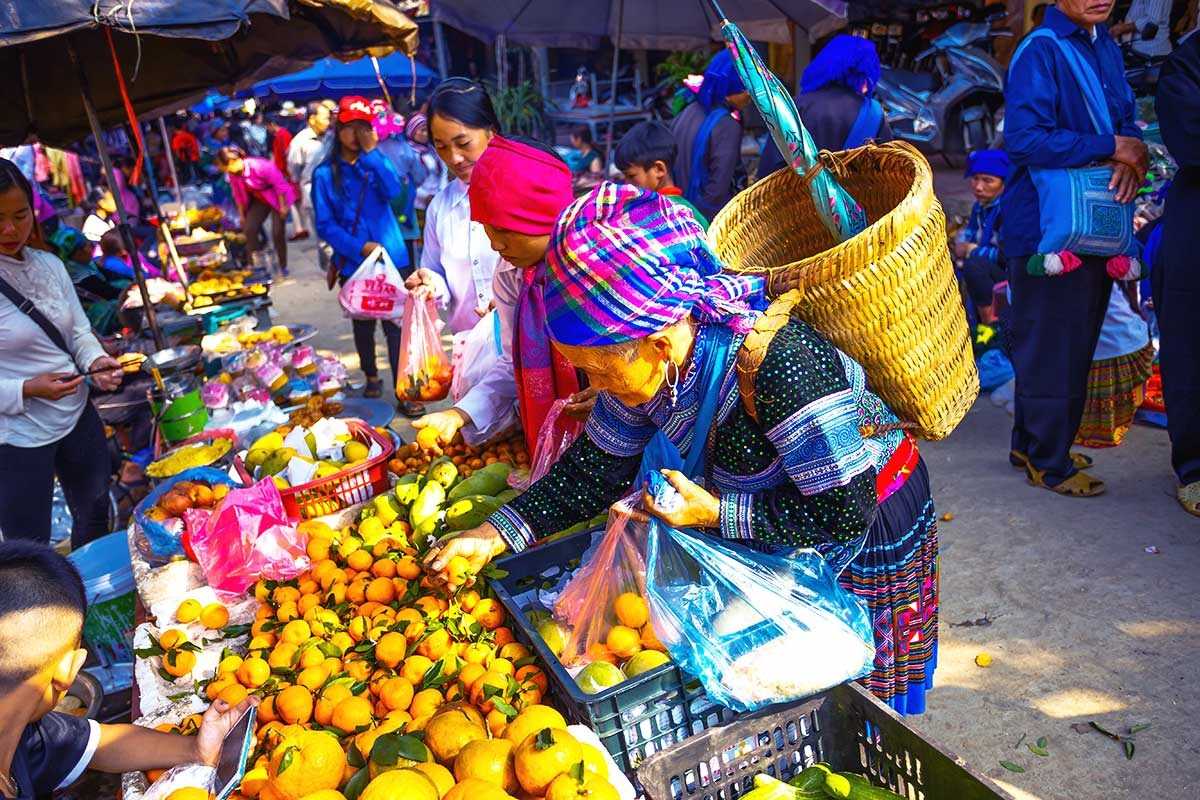
Exploring Beyond – Adventures Around Muong Hum Market Sapa
There’s so much more waiting beyond the bustling stalls of Muong Hum Market Sapa. If you crave more than a day’s exploration, you’ll find endless things to do near Muong Hum—from unforgettable treks to cultural day trips and secret village escapes. This region rewards travelers who linger, offering true Sapa region exploration and authentic encounters at every turn.
Take a look at these adventures and extend your journey—every step off the beaten path reveals another hidden story in Muong Hum, Sapa, and northern Vietnam. Whether you’re a nature lover or a cultural explorer, Muong Hum day trips promise a deeper connection to the region.
Looking to maximize your Sapa region exploration? Read on for the best excursions, scenic walks, and unique village visits—then plan your own adventure with confidence.

Day Trips and Excursions Near the Market
A visit to Muong Hum Market Sapa is just the beginning. The area is a treasure trove for adventurers and curious souls. Whether you’re dreaming of a challenging hike or a gentle day tour, there’s a memorable journey waiting just outside the market gates.
- Go on a Muong Hum trekking adventure: Several local guides offer half- and full-day treks through lush rice terraces, bamboo forests, and picturesque valleys, revealing a side of Sapa few travelers see.
- Discover remote villages near Muong Hum: Spend a day walking or biking to ethnic villages, learning about daily life and time-honored crafts through immersive visits.
- Join expertly guided Sapa excursions: Options range from cultural workshops and farming experiences to hands-on cooking classes, all tailored for authentic local encounters.
Make the most of your trip—ask about day tours or arrange a guided trek through Muong Hum for an unforgettable journey into the region’s heart.
Scenic trekking routes and nature walks
If you crave fresh air and panoramic views, the trails around Muong Hum Market Sapa won’t disappoint. There are hikes for every skill level, each offering a unique window into the local landscape and life.
- Muong Hum hiking trails: Try the scenic loop past terraced rice fields and hillside hamlets—moderate, 2–4 hours.
- Sapa nature walks: Explore shaded bamboo forests, gentle enough for families and rich with birdsong and butterflies.
- Trekking around Muong Hum: More ambitious hikers can tackle challenging routes to hidden waterfalls or mountain viewpoints with the help of a local guide.
- Rice terraces and scenic views: The best times are spring planting or autumn harvest, when the landscape glows gold and green.
With local guides, even beginners can enjoy these walks—each route promises spectacular scenery and genuine encounters with Sapa’s natural beauty.
Want help finding the perfect trek? Email us at Asia Travel Links for expert advice and customized itineraries.
Visiting nearby ethnic villages (Y Ty, Ban Xeo, Den Sang)
The best way to understand the cultural tapestry of Muong Hum and Sapa is to visit neighboring villages. Each has its own distinct charm, offering a warm welcome and new perspectives on rural life.
- Y Ty Sapa: Famed for its misty mountain scenery and unique architecture, Y Ty is a must for anyone seeking photogenic landscapes and authentic village culture.
- Ban Xeo Vietnam: Known for its local markets and friendly hosts, Ban Xeo gives visitors the chance to experience daily routines and traditional festivals up close.
- Den Sang village tour: Small, serene, and ideal for reflection, Den Sang showcases local craftsmanship and sustainable tourism.
Ask your host or guide about local homestay arrangements—staying overnight allows you to experience evening rituals, family meals, and deeper cross-cultural exchanges.
Ready to plan a responsible village visit? Asia Travel Links offers advice and bookings for homestays and guided experiences in Y Ty, Ban Xeo, and Den Sang.
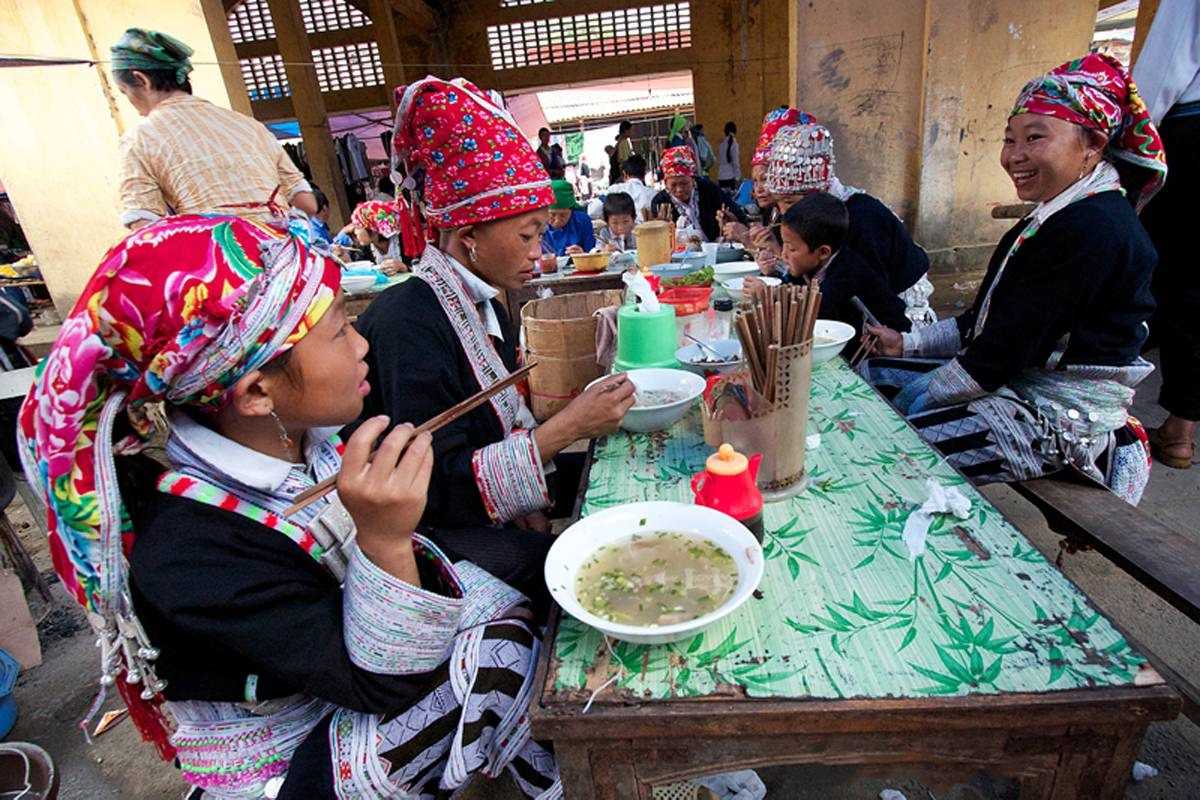
Unique Seasonal and Cultural Events
Every visit to Muong Hum reveals something new, especially if you plan your trip around local gatherings. Throughout the year, the market and the surrounding valleys come alive with Muong Hum festivals, Sapa cultural events, and all kinds of seasonal activities Muong Hum is known for. Whether it’s the buzz of spring planting, the colorful harvest, or the warmth of community celebrations, there’s always a reason to join the festivities in Sapa.
Want to capture the magic of a festival? Check local event calendars before you book—experiencing these moments can turn a simple market visit into an unforgettable journey.
Weekly market day atmosphere
Sunday mornings transform Muong Hum into a vibrant, bustling hub. The Muong Hum Sunday atmosphere is electric—the entire valley stirs to life as vendors, locals, and travelers gather for one of the most exciting weekly Sapa markets. From first light, you’ll hear the sound of laughter, the call of market sellers, and see colorful costumes weaving through the crowd.
- Sunday market: The biggest, busiest day, filled with rare products and the most lively crowd.
- Community gathering: Neighbors and friends from remote hamlets reconnect and share news.
- Local buzz: The energy peaks mid-morning—don’t miss the morning rush.
- Tradition: Sunday is not just for shopping, but for renewing social bonds and cultural rituals.
If you want to soak in the region’s true character, make Sunday your market day. It’s a living, breathing showcase of the best of Muong Hum and Sapa.
Local festivals and traditional celebrations
To experience the most authentic side of Muong Hum, time your trip with a festival or special celebration. The Muong Hum festivals calendar includes major events like ethnic New Year (Tet), spring planting rituals, and vibrant harvest parties. Many ethnic new year Sapa traditions are marked by feasting, music, and colorful ceremonies.
- Festival schedule: Tet (late January/February), major harvest festivals (September/October), and smaller community holidays.
- Annual events: Look out for pop-up performances, traditional games, and special food stalls.
- Local celebration: Unique to each ethnic group, often involving dance, song, or ancestral offerings.
For the best experience, book your trip during these festive times and consider arranging a guided visit with local hosts. Asia Travel Links can help you align your journey with the most meaningful traditional celebrations in Muong Hum, Sapa, and across Vietnam.
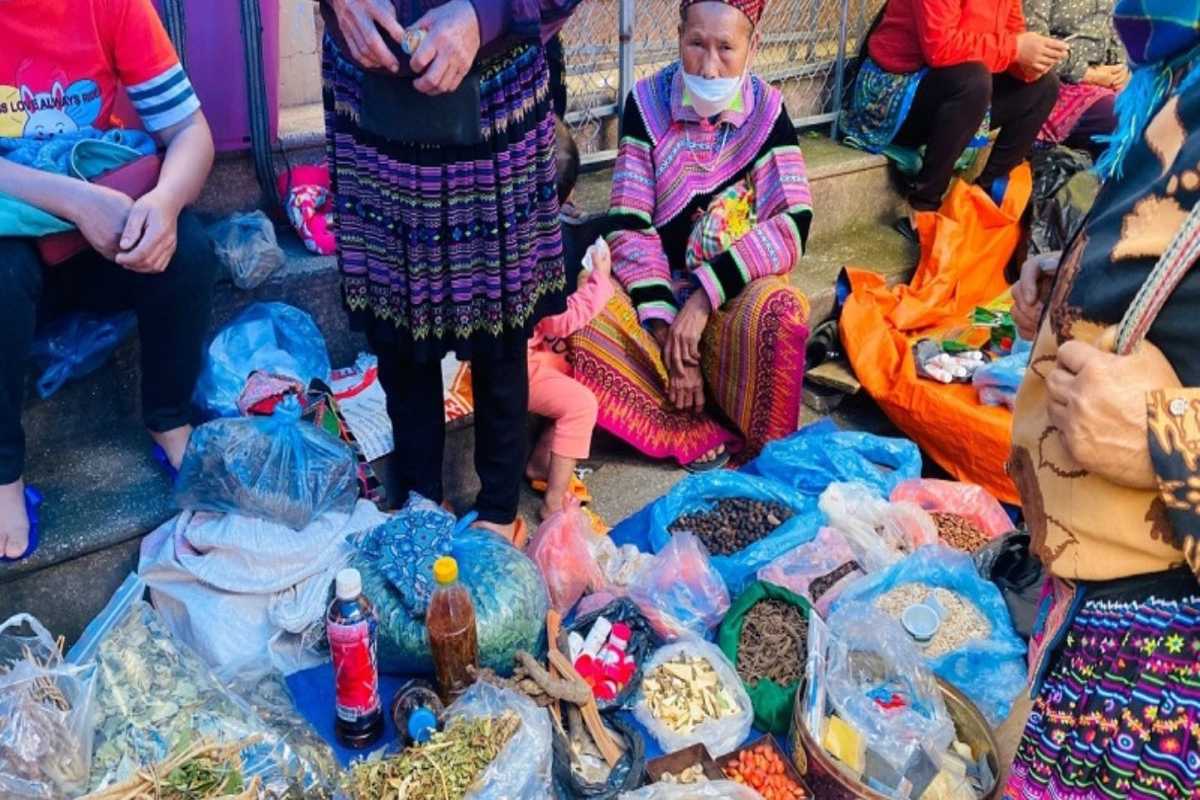
Where to Eat, Stay, and Unwind After Your Visit
After a day exploring Muong Hum and the mountain valleys, nothing feels better than a warm meal and a restful place to sleep. Wondering about the best Muong Hum restaurants, where to stay near Muong Hum, or top spots for Sapa region dining? Here’s how to finish your day on a delicious, relaxing note. From cozy guesthouses to rustic village eateries, these recommendations take the guesswork out of your travel planning and help you connect with the best of local hospitality. Don’t just visit—make yourself at home in Muong Hum and Sapa.
Top local eateries and what to order
Searching for the best food Muong Hum has to offer? Start with these trusted spots, each serving up authentic flavors of the region. From family-run kitchens to lively food stalls, Muong Hum local cuisine is hearty, fresh, and full of character. For a real taste of authentic Sapa food, try these must-visit eateries and menu highlights:
- Local food stalls: Sample freshly grilled pork skewers, sticky rice, and handmade rice noodles from bustling stalls along the market road.
- Guesthouse dining: Many guesthouses offer home-cooked meals—ask for “thang co” (a traditional highland stew) or seasonal wild vegetable dishes.
- Popular rice eateries: Order “com lam” (bamboo-tube rice) and “thit ga den” (black chicken) for a true local specialty.
- Pho corner: Warm up with a bowl of fragrant, herbal pho, made with mountain herbs.
- Coffee shops: Unwind with strong Vietnamese drip coffee and mountain honey after your meal.
Whether you’re hungry for a snack or a full meal, Muong Hum is ready to welcome you at the table. For more insider dining tips or help booking a guesthouse dinner, email us or chat with Asia Travel Links.
Homestays, guesthouses, and village accommodations
For a memorable Muong Hum overnight stay, skip the big hotels and opt for authentic Sapa accommodation in the heart of the mountains. From simple bamboo guesthouses to immersive village homestays near Sapa, there’s something for every traveler’s style and budget. Consider these standout options:
- Family homestays: Experience daily life with a local family—expect shared meals, storytelling, and the comfort of a warm hearth.
- Village guesthouses: Private rooms and shared facilities with sweeping valley views and fresh mountain air.
- Eco-lodges: Sustainable stays that blend local architecture with modern amenities, often surrounded by rice terraces or gardens.
- Budget inns: Clean, simple, and central to the market—ideal for solo travelers or short stays.
- Ethnic-run stays: Learn directly from Hmong, Tay, or Dao hosts about their unique culture and crafts.
Booking is easy: Contact your preferred host directly, or let Asia Travel Links recommend and reserve your stay based on your interests and group size. Sleep well knowing your visit supports local families and preserves authentic hospitality in Muong Hum and Sapa.
Top of Form
Bottom of Form
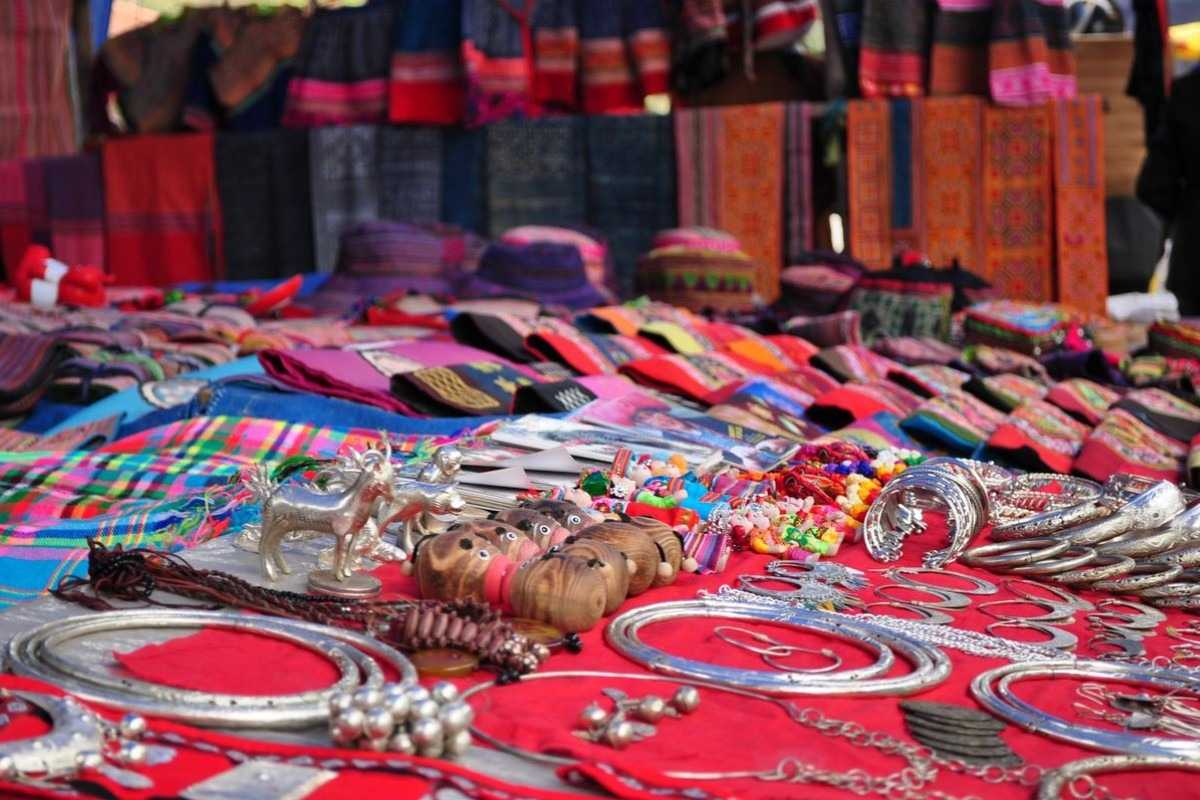
Supporting Local Communities & Responsible Travel
Choosing to visit Muong Hum Market Sapa is more than just a unique adventure—it’s an opportunity to practice responsible tourism Sapa and truly support local Muong Hum communities. Every thoughtful choice you make, from where you shop to how you engage, can have a positive impact. This section guides you to travel consciously, enjoy authentic exchanges, and help protect the natural and cultural heritage of Sapa and northern Vietnam for generations to come. Your journey can leave a lasting, uplifting legacy.
Before your visit, consider how you can make each step of your journey count. By embracing ethical travel Vietnam, you’ll enjoy deeper experiences and help shape a brighter future for the region.
If you’d like tailored advice on traveling responsibly, don’t hesitate to email us or consult Asia Travel Links for recommendations and local support.
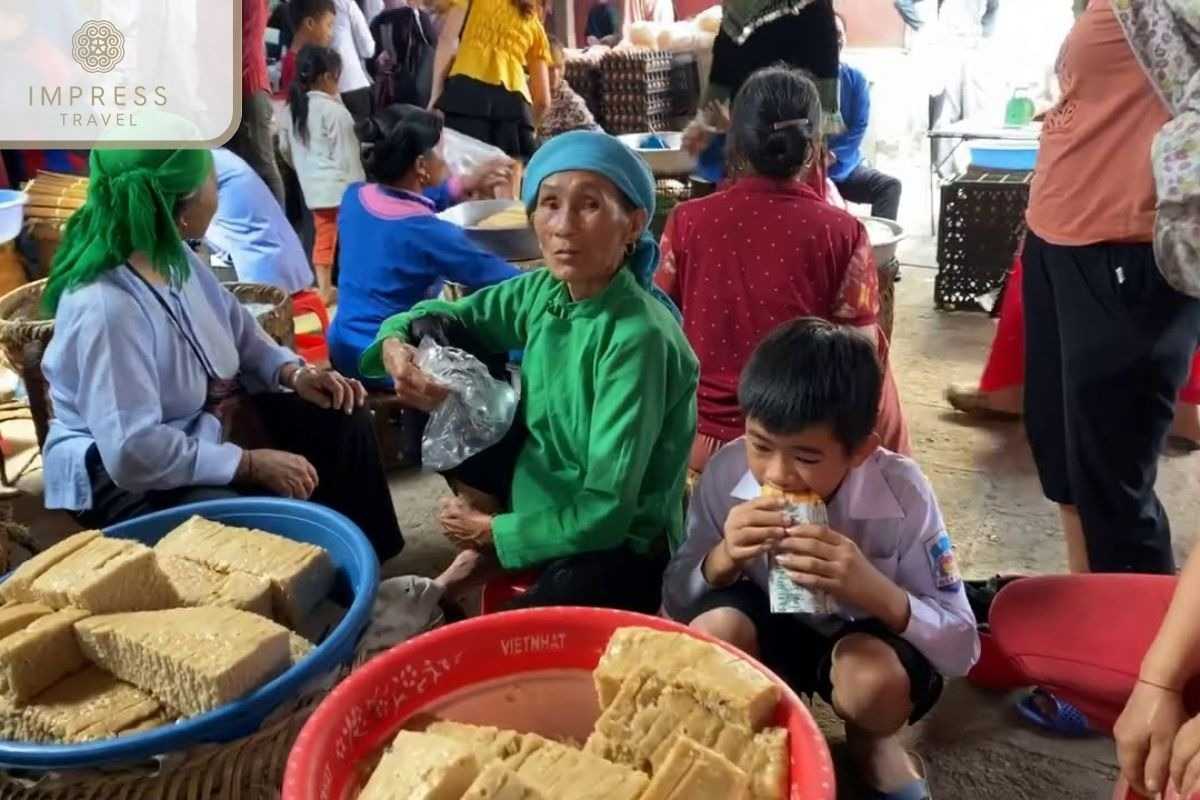
How Your Visit Makes a Difference
Visiting Muong Hum Market Sapa is a powerful way to create positive change in the highlands. When you choose to spend time and money here, you directly support local families and help preserve age-old traditions. The Muong Hum tourism impact goes far beyond what meets the eye—your purchases and presence help fund education, protect cultural practices, and build community resilience.
Responsible travel isn’t just about what you see, but about the connections you nurture. The true benefits of responsible travel Sapa include:
- Immediate income for local farmers, artisans, and guides, sustaining families through the seasons.
- Increased pride and visibility for traditional crafts, music, and foods, inspiring the next generation.
- Funding for community projects, infrastructure, and cultural festivals through your support.
Even small choices matter. Whether it’s buying a handmade textile or staying in a family-run homestay, you are a partner in the long-term vitality of Muong Hum and Sapa.
You can take action right now—plan your trip with a focus on community impact, and ask us how you can be part of meaningful local experiences.
Supporting sustainable tourism and local crafts
Making a difference in Muong Hum, Sapa, and Vietnam is simple when you focus on direct community support and sustainability. Here are the best ways to ensure your visit boosts the local economy and preserves traditional crafts:
- Buy directly from artisans: Purchasing textiles, baskets, or silverwork at the market ensures your money goes to the maker, not middlemen.
- Book ethical tours: Choose operators who hire local guides, pay fair wages, and follow environmentally responsible practices.
- Stay in locally owned lodgings: Guesthouses and homestays run by ethnic families provide a deeper connection—and every night you book helps a local household.
- Ask about fair trade: Look for signs or ask sellers about the origins of products; support stalls where goods are made using traditional methods.
- Limit haggling on unique items: While bargaining is expected, paying a fair price for handcrafts supports artisans and sustainable practices.
Every mindful purchase, stay, or experience strengthens Muong Hum’s future and honors the land’s creative spirit. Need help connecting with artisan workshops or ethical guides? Contact Asia Travel Links for personalized, responsible travel planning.
Responsible travel tips for a positive impact
To maximize your positive influence at Muong Hum Market Sapa, follow these practical steps for ethical, eco-friendly, and respectful travel:
- Minimize plastic use: Bring your own reusable bag and water bottle, and say no to single-use plastics at the market.
- Dress modestly: Out of respect for local customs, cover shoulders and knees, especially in sacred or rural areas.
- Ask before photographing people: A smile and a polite gesture go a long way—always request permission before snapping a portrait.
- Support local eateries and stalls: Choose meals and snacks made by local families to keep your spending in the community.
- Learn key phrases: Simple Vietnamese greetings and thank-yous help build bridges and show respect.
- Dispose of waste responsibly: Use bins or take your trash with you, keeping nature and the village clean for everyone.
Traveling with these Muong Hum ethical travel tips in mind ensures that your journey brings benefit—not burden—to the community and the environment. For a complete checklist or to join a community service activity during your trip, email us at Asia Travel Links.
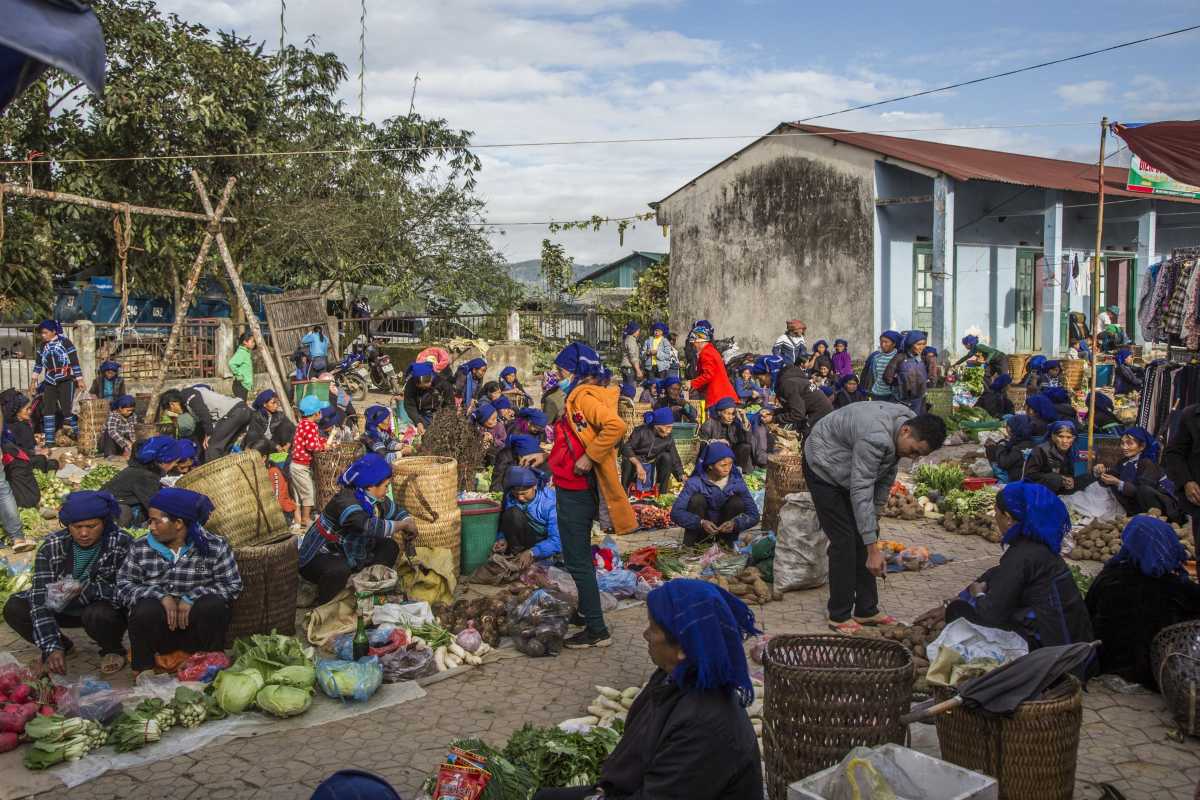
Preserving Culture and Nature
Visiting Muong Hum Market Sapa is more than a journey into a vibrant rural market—it's a chance to support Muong Hum conservation, safeguard ancient customs, and help ensure cultural preservation Sapa remains a living reality for future generations. This landscape is shaped by tradition and by the gentle, seasonal rhythms of the land. When you travel mindfully and engage respectfully, you are joining a growing movement for environmental protection Vietnam and cultural continuity in the heart of the northern highlands.
The balance between honoring heritage and protecting fragile ecosystems requires ongoing commitment from both locals and travelers. Every conscious step—whether it’s learning about minority traditions, respecting sacred sites, or choosing eco-friendly experiences—helps protect the unique tapestry that makes Muong Hum, Sapa, and Vietnam so unforgettable.
By seeking out ways to give back and traveling with intention, you play a part in ensuring this special region remains vibrant, resilient, and inspiring for many years to come. If you wish to learn more about sustainability programs or responsible travel experiences, reach out to Asia Travel Links for guidance on how to make your visit count.
Community efforts and visitor guidelines
Both the people of Muong Hum and the wider Sapa region are increasingly involved in conservation and cultural preservation. Here’s how you can support ongoing Muong Hum community projects and show Sapa cultural respect during your visit:
- Join community-based tourism projects: These are led by local families and designed to benefit the village as a whole—look for tours or workshops that highlight traditional crafts, farming, or cooking.
- Attend cultural festivals and workshops: Participate respectfully and ask questions about meaning or history; this curiosity is valued and deepens your experience.
- Respect sacred and communal spaces: Always ask before entering homes, temples, or other spiritual areas, and follow posted guidelines or local advice.
- Volunteer or contribute to local conservation efforts: Some villages organize trail clean-ups, reforestation, or educational sessions—ask about opportunities to join in.
- Share your appreciation: Leave positive reviews for projects or guides who prioritize cultural and environmental protection, helping them thrive.
By observing these simple guidelines, you help sustain both the living culture and the natural beauty that make Muong Hum so special.
How to support conservation while exploring
Travelers can actively contribute to the protection of Muong Hum’s ecosystem and biodiversity. To maximize your positive impact and embrace Muong Hum eco-tourism, follow these sustainable exploration tips:
- Stick to marked trails: This protects sensitive plants, prevents erosion, and helps preserve habitats for wildlife.
- Avoid picking plants or disturbing animals: Many species are rare or play vital roles in the ecosystem.
- Pack out all litter: Bring a bag for your trash and pick up any you see along the way, leaving the area cleaner than you found it.
- Learn about local flora and fauna: Join a guided walk to discover native species and how communities use them sustainably.
- Participate in clean-up or biodiversity projects: Ask your host or guide about ongoing efforts for Sapa biodiversity protection and how you can help.
- Limit water and energy use: Many rural areas have limited resources; small steps like short showers or turning off lights make a difference.
By taking these actions, your adventure supports both the cultural and ecological richness of Muong Hum and Sapa. If you want to connect with conservation groups or need tips for low-impact travel, contact Asia Travel Links for the latest opportunities to get involved.

Unearthing Unique Souvenirs & Local Crafts
For travelers who love to bring a piece of their journey home, Muong Hum Market Sapa is a treasure trove of handmade beauty, heritage, and meaning. This vibrant traditional market is a living gallery—each stall brimming with crafts that reflect local stories, ethnic pride, and generations of skill. Whether you’re after the ultimate Muong Hum shopping guide, searching for the best souvenirs Muong Hum, or seeking out Sapa crafts for sale that carry genuine cultural weight, this is where authentic shopping comes alive.
Here, every object tells a story. The weaver’s hands, the silversmith’s tools, the herbalist’s careful bundles—each reveal a piece of Muong Hum, Sapa, and Vietnam that is impossible to find anywhere else. Prepare to immerse yourself in a world of color, tradition, and artistry. Shop thoughtfully, support local artisans, and discover how your choices can make every souvenir more than just an object—it becomes a memory, a connection, and a symbol of your adventure. For tips on navigating the market or booking a guided craft tour, reach out to us at Asia Travel Links.
Experience the heart of Muong Hum Market Sapa and take home a story you can hold.

The Art of Muong Hum: Traditional Handicrafts
The shopping experience at Muong Hum Market Sapa is defined by its extraordinary variety of handmade treasures. What sets these goods apart is not just their beauty, but the centuries-old skills, time-intensive processes, and cultural symbolism behind them. Many artisans here use methods passed down from their ancestors—an act of preservation as much as creativity.
You'll find Muong Hum traditional crafts crafted from local bamboo, wood, hemp, indigo, silver, and even bone. Expect to see Sapa handmade goods like hand-woven baskets, embroidered clothing, and ceremonial items on display. The artistry of this region reflects a deep-rooted sense of place, spirituality, and ethnic identity, making every purchase a direct link to the living heritage of Muong Hum, Sapa, and Vietnam.
Whether you’re a casual browser or a passionate collector, exploring the market’s handcraft stalls is an experience that goes far beyond shopping. Look for moments to chat with artisans, ask about the origins of their designs, or watch demonstrations to gain a richer appreciation for their work.
Ready to learn which crafts should be at the top of your must-buy list? Don’t leave without checking out these stunning local specialties.
Textiles and Embroidery: Stories Woven in Cloth
Among the most coveted finds in Muong Hum Market Sapa are textiles and embroidery—works of art that blend history, identity, and vibrant color. Each piece is hand-stitched by artisans from different ethnic groups, telling stories with every thread.
- Hmong embroidery Muong Hum: Look for rich, geometric patterns, often created with bright threads on hemp cloth. Hmong women specialize in both clothing and decorative panels, often using hand-dyed indigo for deep blue backgrounds.
- Dao textiles Sapa: The Red Dao are renowned for their indigo-dyed cotton and intricate cross-stitch embroidery. Their designs often feature spiritual motifs, floral patterns, and symbolic borders.
- Traditional Vietnamese weaving: You’ll spot handwoven blankets, scarves, and bags using bamboo looms. Each group’s weaving patterns are unique—some with bold color blocks, others with subtle, earthy tones.
- Motifs and meanings: Common symbols include birds (luck), spirals (eternity), and plants (connection to nature). Many artisans will happily explain the stories behind their patterns.
When buying textiles, ask about natural dyes or traditional processes for a true keepsake. This attention to detail not only elevates your purchase but supports the continuation of these remarkable skills.
If you’re not sure how to spot quality, just ask your vendor for a demonstration or explanation—most are proud to share the background of their work. These pieces are lightweight and packable, making them ideal gifts or personal mementos of your time in the highlands.
Want to see the artisans at work or try your hand at embroidery? We can connect you to workshops or private demonstrations—just let Asia Travel Links know your interests.
Silverwork and Jewelry: Adornments with Meaning
Silver jewelry is more than just decoration at Muong Hum Market Sapa—it is a form of cultural identity, a symbol of protection, and a proud marker of status for many local groups.
- Muong Hum silver jewelry: Shop for chunky bangles, ornate earrings, engraved necklaces, and decorative hairpins. Each item is traditionally handmade by local silversmiths using age-old methods.
- Ethnic silver Sapa: Hmong and Dao artisans often shape silver into protective amulets, beads, and bridal pieces. These are popular as gifts for their beauty and spiritual significance.
- Traditional Vietnamese jewelry: Unlike mass-produced trinkets, genuine pieces are weighty, imperfect, and often bear small hand-tool marks—a sign of authenticity.
- How to identify quality: Ask about the maker, inspect for solder marks or cast seams (a sign of factory work), and choose pieces with meaningful engravings.
- Cultural meaning: Silver is believed to ward off evil spirits and is given during important life events, making these adornments treasured heirlooms.
Buying direct from artisans ensures your money stays in the community and helps preserve traditional skills. If you’re interested in learning more or want to commission a special item, Asia Travel Links can introduce you to trusted silversmiths in Muong Hum, Sapa, and across Vietnam.
Discover the beauty and meaning of each piece, and take home a symbol of your unforgettable Sapa journey.

Local Delicacies and Produce to Take Home
Shopping at Muong Hum Market Sapa is not just about crafts—it’s also a chance to bring home unforgettable flavors. From vibrant condiments to nourishing snacks, the region offers a wealth of Muong Hum local products, perfect for gifts or personal treats. These edible souvenirs let you extend the market’s magic long after your journey, sharing a taste of the mountains with friends or family. Explore the best Sapa specialty food and discover the most tempting culinary souvenirs Vietnam has to offer in this highland market.
Many vendors will happily wrap your selections for travel, so don’t hesitate to ask for advice on storage and packing. Most of these delicacies are sold by weight or in sealed bags, making them easy to transport and store.
Curious what to look for? Here’s a rundown of the most unique, easy-to-carry food treasures you’ll find in Muong Hum, Sapa, and beyond.
Exotic Spices and Medicinal Herbs
The spice stalls at Muong Hum Market Sapa are bursting with color and aroma—your senses will know you’ve arrived before you see them. Local herbalists display everything from fragrant cinnamon sticks to bundles of star anise, all grown in the cool mountain air.
- Muong Hum herbs: Discover wild-foraged roots, healing balms, and dried flowers prized by local families for both cooking and traditional remedies. Ask about herbal teas for sleep or stamina.
- Sapa spices: Stock up on intensely aromatic cinnamon, spicy cardamom, and star anise—key ingredients in local stews, broths, and pho. Each spice adds a touch of the region’s unique terroir.
- Vietnamese traditional medicine ingredients: Find dried medicinal mushrooms, herbal blends for colds or digestion, and even forest honey. Locals are happy to share preparation tips.
- How to pack and use: Herbs and spices are best bought in small, airtight bags. Label your finds for easy use back home and always check local import rules if you’re traveling internationally.
- Ask for advice: Many sellers can recommend how to use these treasures, whether in your next meal or as a natural remedy.
Exploring these stalls is as educational as it is delicious—every purchase supports rural families and preserves ancestral knowledge. If you’d like more info on particular ingredients or need help translating labels, ask Asia Travel Links for expert assistance.
Unique Local Brews and Teas
No visit to Muong Hum Market Sapa is complete without sampling or purchasing a bottle of homemade rice wine or a pouch of highland tea. These drinks are more than souvenirs—they’re a window into local celebration, hospitality, and daily life.
- Muong Hum rice wine: Distilled in small batches, this earthy, slightly sweet brew is served at festive gatherings and family meals. Look for clear, unfiltered varieties in recycled bottles, and ask vendors about safe drinking and recommended brands.
- Sapa local tea: Highland green teas, oolong, and specialty herbal blends—like artichoke or wild forest leaves—offer rich, complex flavors. Most are hand-picked and sun-dried, with little processing.
- Traditional Vietnamese alcohol: Besides rice wine, you may encounter corn wine or infusions with wild fruits and roots. These are potent and full of character—taste before you buy if possible.
- Buying and transport tips: Purchase tea in vacuum-sealed bags for freshness. For alcohol, opt for well-sealed bottles or jars, and pack them securely in your luggage. Vendors can usually help wrap items for travel.
- Gifting ideas: Both rice wine and tea make thoughtful presents and spark conversations about your Sapa adventure.
Ready to bring home a taste of the highlands? Let us know if you’d like help arranging a tasting or sourcing trusted local products during your visit with Asia Travel Links.

Handy Tips from Seasoned Travelers
Every trip to Muong Hum Market Sapa is a little different, but the best experiences come from learning directly from those who’ve been before. Here, real traveler reviews and street-smart advice converge, equipping you with the insights, tips, and recommendations you’ll need to navigate this unforgettable mountain market like a pro. Want to know what seasoned visitors wish they’d done differently, or the small tricks that made their trip? Read on for genuine tips you won’t find in generic guides.
Taking a moment to prepare with local advice can mean the difference between a stressful trip and a seamless, joy-filled adventure. The wisdom here is gathered from honest Muong Hum traveler reviews—practical, firsthand, and road-tested for your peace of mind. If you have your own tips or want to ask a specific question, you can always reach out to us at Asia Travel Links.

What Past Visitors Wish They Knew
Many who come to Muong Hum Market Sapa wish they’d known a few things in advance—small details that save time, money, or frustration. Here’s a collection of “aha!” moments and travel lessons learned by real visitors. Use these as a starting point for your own Sapa adventure.
- Don’t underestimate the early morning: The best stalls and most vibrant atmosphere are in the first hours after sunrise. Late arrivals may miss out on key experiences.
- Cash is king: There are no ATMs at the market, and few vendors can make change for large bills. Bring plenty of small notes.
- Pack for all weather: Even in summer, mist or a mountain shower can roll in. Layers and a lightweight rain jacket are a must.
- Slow down: The charm of Muong Hum is in the slow pace, quiet observation, and unplanned encounters. Don’t rush your visit.
- Take the side alleys: Some of the most interesting goods and interactions are tucked away from the main paths.
Making use of these Sapa traveler insights will not only help you avoid regret, but will also open the door to a more personal and rewarding experience at the market.
Unexpected highlights and helpful advice
The most memorable moments at Muong Hum Market Sapa are often the ones you don’t see coming. Here’s what seasoned travelers say stands out—and what you might miss if you only follow the crowds.
- Local breakfast surprises: Try a hot bowl of thang co (herbal stew) from a roadside stall. It’s filling and uniquely local.
- Warm welcomes: A smile and a friendly greeting go a long way. Many locals will invite you for tea or a photo if you show respect.
- Muong Hum hidden gems: Check the bridge area in the early morning for spontaneous gatherings, performances, or photo ops.
- Off-the-menu snacks: Some vendors offer delicacies not found elsewhere—ask what’s fresh today for a true taste of Sapa.
- Insider tips Sapa: If you’re not sure what to buy, follow the crowds of locals, not the tourists. Their favorite stalls are often the best kept secrets.
Unexpected moments make every visit to Muong Hum unique—be open, curious, and ready to discover.
Common mistakes to avoid
Travelers love Muong Hum Market Sapa—but even experienced visitors can run into avoidable snags. Here’s how to sidestep the most common pitfalls.
- Don’t rely on digital payments: Vendors only accept cash and mobile data can be patchy. Plan ahead for purchases.
- What not to do in Muong Hum: Avoid bargaining aggressively; a gentle approach is appreciated and builds good will.
- Arriving late: The market starts before dawn and slows by midday. The liveliest action is gone by early afternoon.
- Skipping the weather check: Mountain weather changes quickly—always bring a rain cover, even if it looks sunny.
- Not learning a few local phrases: Simple Vietnamese greetings or thank-yous are welcomed, and make transactions friendlier.
By keeping these Muong Hum travel pitfalls and avoiding mistakes Sapa in mind, you’ll ensure a smooth, memorable adventure—one that’s free of unnecessary hassle and full of genuine connection.

Practical Packing and Safety Tips
Getting ready for Muong Hum Market Sapa means more than just choosing what to wear—it’s about smart preparation and having the right safety mindset. Here’s your practical, field-tested Muong Hum safety guide, shaped by travelers who’ve faced all kinds of weather, market crowds, and remote-mountain quirks. A bit of know-how goes a long way to making your visit smooth and stress-free.
From packing essentials to real-world safety advice, every tip below is meant to build your confidence for the trip. The market’s rural setting and changing conditions reward travelers who come prepared. Keep these checklists handy, and you’ll be ready for anything Muong Hum and Sapa throw your way.
Staying comfortable and safe in all seasons
It’s easy to be caught off guard by the weather at Muong Hum Market Sapa—mornings may be chilly, afternoons warm, and rain showers can arrive with little warning. Use this checklist to stay comfortable and healthy no matter when you visit.
- Waterproof jacket or rain poncho: Essential for surprise downpours, especially from May to September.
- Sun hat and sunscreen: UV rays are strong, even on cloudy days. Don’t skip sun protection.
- Mosquito repellent: Necessary for summer months or if you plan to explore village areas.
- Comfortable, sturdy shoes: Expect muddy paths or uneven ground, especially in the rainy season.
- Layered clothing: Mornings are cool; layers let you adapt as the day warms.
- Reusable water bottle: Stay hydrated and minimize plastic waste.
- Basic first-aid kit: Include plasters, antiseptic, and any needed medication—remote areas mean limited supplies.
These Muong Hum weather gear and Sapa safety tips will keep you dry, protected, and ready for the unexpected. Packing for Sapa seasons is about comfort and caution—don’t leave it to chance.
Local contacts for emergencies or guidance
When you’re far from home, having the right numbers and local support can make all the difference at Muong Hum Market Sapa. Keep this contact list saved and share it with your travel companions.
- Local police: Muong Hum Police Station – (add local number here if available)
- Tourist information: Sapa Tourist Office – (add Sapa office number)
- Lao Cai Province support: Lao Cai Tourist Hotline – (add number)
- Emergency (general): 113 (Police), 115 (Ambulance/Medical), 114 (Fire)
- Trusted local guides: Ask your accommodation for recommendations; they often partner with reliable, experienced guides.
- Embassy support (if needed): Have your embassy or consulate details for Vietnam handy, especially if traveling with children or in a group.
You can also email us for updated emergency contacts and Sapa travel support—having help a call or text away is a simple step that can save your trip. Whenever possible, book your experience or local guides through a reputable operator like Asia Travel Links for extra peace of mind.

What to Expect When You Go – Setting the Scene
Let the anticipation build as you imagine your first steps into Muong Hum Market Sapa, where mountain mists melt away to reveal a vibrant, living tapestry of color, sound, and human connection. This is a place where time slows, traditions thrive, and every visitor becomes part of a larger story—one shaped by nature, community, and the enduring spirit of the highlands. If you’re searching for an authentic adventure, this Muong Hum travel guide summary will help you set expectations, spark your curiosity, and nudge you one step closer to an experience you’ll carry with you long after you leave the valleys of Sapa in northern Vietnam.
As you plan, know that what awaits is both simple and extraordinary: a genuine welcome, a sensory feast, and a reminder that some of life’s richest discoveries happen far from the well-trodden path. When you’re ready to take that step, let these final insights guide your journey—then come and write your own chapter in the market’s story.

The Sights, Sounds, and Spirit of Muong Hum Market
Step into Muong Hum Market Sapa, and you enter a world alive with movement and meaning. The air vibrates with the laughter of traders, the rhythmic calls of vendors, and the melodic tones of local dialects. Everywhere you look, vibrant garments flutter like banners against the green hills, while baskets overflow with fresh produce, bright flowers, and handwoven goods. The Muong Hum atmosphere is a fusion of scents—herbs, grilled meats, incense, and the sweet dampness of earth after morning rain.
It’s more than a market; it’s a celebration of life’s essentials. The Muong Hum sensory experience is an immersion into local rhythms, where every greeting is genuine and every exchange—whether a handshake or a smile—connects you to the heart of the highlands. Here, the spirit of Sapa markets is felt in every moment of generosity, laughter, and welcome, making you not just a visitor but a cherished guest.

How the Market Changes Throughout the Year
No two visits to Muong Hum Market Sapa are ever the same. From the bright blossoms of spring to the golden harvests of autumn, the market mirrors the region’s natural rhythms and social calendar. These Muong Hum seasonal changes shape every aspect of the market experience, transforming goods on display, the festive attire of ethnic groups, and even the size of the crowds. Understanding these Muong Hum market variations helps you pick the perfect moment for your adventure.
- In the rainy summer months, the market is quieter, with lush scenery and fewer tourists—ideal for those seeking a calm atmosphere and authentic local interactions.
- Autumn and harvest season bring a dazzling abundance of seasonal produce Sapa—from wild mushrooms to sticky rice—while traders arrive in their most ornate traditional dress.
- The Muong Hum low season offers more space to explore and connect with vendors; the Muong Hum high season (festivals and dry months) is alive with energy, color, and rare market-only rituals.
- Ceremonial events and major festivals fill the air with song, prayer, and even dance, turning the market into a living stage for the community’s deepest traditions.
By matching your visit to these seasonal differences, you can craft an experience tailored to your own expectations—whether that’s peaceful browsing, immersive celebration, or a taste of every mood the market holds.
Seasonal differences in crowds, weather, and goods
Every season at Muong Hum Market Sapa brings its own flavors, sights, and surprises. Here’s how crowds, weather, and goods change through the year:
- Muong Hum low season (May–September): Expect misty mornings, light rain, and a peaceful market vibe. Fewer tourists mean closer encounters with vendors and deeper conversations.
- Muong Hum high season (October–April): Bright, clear weather draws more visitors, while the market is bursting with seasonal produce Sapa—think forest mushrooms, mountain honey, and vibrant vegetables.
- Festival days: Special events see villagers donning their finest ceremonial attire and celebrating with music, dance, and shared meals.
- Harvest time: Watch for market tables heaped with fresh rice, local corn, and rare wild herbs only found during this window.
- Weather surprises: Always be ready for mountain unpredictability; a sunny start can turn into a dramatic rainstorm by afternoon, adding a fresh layer to the experience.
By considering these seasonal differences, you can choose the timing that matches your travel style—whether you want energy and spectacle or tranquility and depth.
Ready to set your own expectations? Start your journey to Muong Hum Market Sapa with open eyes and an adventurous heart. Every season, every visit, is a new story—come and discover which one is waiting for you. If you need help with planning or booking, reach out to Asia Travel Links for personal tips and up-to-date advice.

Why You’ll Love Your Muong Hum Market Adventure
From the first moment you arrive, you’ll discover that a visit to Muong Hum is so much more than a day at a market—it’s an unforgettable Sapa experience that stays with you. Whether you come searching for rare crafts, the thrill of a new taste, or the chance to witness a centuries-old way of life, the rewards are real and deeply felt.
Here, authenticity isn’t a promise; it’s a lived reality. You’ll find genuine hospitality in every smile, honest curiosity in every conversation, and a spirit of openness that invites you to join in rather than simply observe. The joy of cultural exchange is everywhere—sharing a bench with a local grandmother, learning a phrase in an unfamiliar language, or receiving a handwoven bracelet as a token of thanks.
Many travelers leave glowing Muong Hum reviews, citing not just the colorful scenes and lively sounds, but the quiet, personal moments: a warm bowl of soup on a chilly morning, laughter exchanged despite language barriers, or the surprise of being invited to a family’s festival table. These are the true highlights—the memories you’ll cherish long after your trip ends.
If you’re still wondering about the reasons to visit Muong Hum, consider this: you’ll return with stories to share, friendships begun, and a deeper connection to the beauty and resilience of Sapa’s highland people. Let this be the journey that surprises you, inspires you, and reminds you why we travel in the first place.
Take the first step toward your own Muong Hum adventure—plan, dream, and get ready for a market experience that will become one of your favorite stories. Need help organizing your visit or want local tips? Asia Travel Links is here to make your adventure smooth and memorable.

Share Your Stories and Questions!
Your journey to Muong Hum Market Sapa doesn’t end when you leave the valley. It continues with every story, photo, and tip you share. By joining the conversation, you help create a vibrant Muong Hum travel forum that inspires and informs future travelers. We invite you to add your voice—your experience matters and your advice could shape someone else’s adventure.
If you’ve explored Muong Hum, found a hidden corner, snapped a photo you love, or learned something unexpected, this is your chance to be part of a growing community. Whether you want to share Muong Hum story or simply see what others have discovered, you’re welcome here.
Ready to get involved? Ask a question, post a review, or join a group of passionate Sapa explorers. Here’s how you can connect, contribute, and make the most of your travel experience:

Tell Us About Your Muong Hum Experience
What was your most memorable moment at Muong Hum? We’d love to hear your story! Share your favorite memory, a unique discovery, or a stunning photo from your trip in the comments below—or tag us on social media with #MuongHumMarketSapa. Your insights, tips, and even challenges will help others and become part of our collective Muong Hum traveler reviews. Did you uncover a hidden stall, try something new, or make a local friend? Don’t be shy—share Muong Hum story and inspire fellow travelers.
Have a photo you’re proud of? Submit it to our next Muong Hum photo contest for a chance to be featured! There’s no better way to help others plan than by showing what you experienced firsthand.

Ask Your Questions or Get Personalized Tips
Curious about planning your trip, need advice on what to pack, or want the inside scoop on the best time to visit? This is the place to ask! No question is too big or too small. Post your Muong Hum travel questions below, and one of our Sapa experts (or another helpful traveler) will respond. Looking for customized advice? Just let us know—ask a Sapa expert or request personalized Muong Hum tips to get all the support you need before you go.
We’re here to help make your trip smooth, memorable, and uniquely yours.

Join the Conversation with Fellow Travelers
The real magic of travel comes from community. Join our Muong Hum travel community and swap tips, stories, or even travel plans. We recommend joining an active Sapa travel forum or connecting with likeminded explorers on Facebook, WhatsApp, or Asia Travel Links’ network. It’s a great way to connect with travelers Vietnam-wide, share recommendations, and ask anything on your mind.
So don’t just plan your adventure—be part of a growing network of friends and fellow explorers. Engage, comment, and help make this guide better for everyone who loves Muong Hum, Sapa, and the magic of travel in Vietnam.
Ready to start sharing or want expert help with your next journey? Drop your story, join a group, or email us at contact@asiatravellinks.com. Let’s build something special together—one adventure, one question, one memory at a time.
Nhật Hoàng
Faqs
Muong Hum Market Sapa is famous for its vibrant ethnic culture, unique highland atmosphere, and authentic rural trading scene. Travelers visit for a truly local experience that is different from the more touristy markets in the region.
You will find traditional crafts, fresh produce, and colorful gatherings of local people every Sunday. The market is a meeting place for minority groups, making it a window into northern Vietnam’s cultural diversity.
If you want to experience real highland life and culture, add this unique market to your travel plans.
You can reach Muong Hum Market Sapa from both Sapa and Lao Cai by road. The journey takes you through scenic mountain landscapes and ethnic villages.
- From Sapa, travel by private car, shared van, or rented motorbike. The distance is about 45 kilometers, with travel times ranging from 1.5 to 2 hours.
- From Lao Cai, the route is around 40 kilometers and also takes about 1.5 hours. Local buses or taxis are available, but private vehicles offer more flexibility.
- Roads can be winding and sometimes rough, so plan for a slower pace and check weather conditions before you go.
Planning your transport in advance will help ensure a smooth and enjoyable trip.
The best time to visit Muong Hum Market Sapa is on Sunday morning, which is the main market day, and during the dry season from October to April.
- Sundays are when the market is at its liveliest, with local communities gathering from early morning.
- Dry season months bring clear skies, comfortable temperatures, and safer road conditions.
- Harvest and festival times (typically September and October) offer extra cultural highlights.
Arrive early to see the market at its most authentic and avoid midday crowds.
There is no official entry fee for Muong Hum Market Sapa. Visitors can freely explore the market and its surrounding area.
- You only need to pay for any purchases or food you enjoy at the market.
- Some surrounding sites or homestays may have separate charges.
- Bring small denomination cash, as there are no ATMs nearby and most vendors do not accept cards.
Enjoy the authentic local culture without worrying about hidden costs.


